Jakarta airport did not seem unduly affected by the bombs that had exploded the previous day in the city centre. Indeed, the fear of swine flu was much greater - there were surgical masks everywhere and where those were lacking, people were happy to use the in-flight eye masks or hands to protect themselves against the dreaded virus. And there was a good deal more upset that Manchester United had canceled the Indonesia leg of their southeast Asia tour - they had been due to stay at the Jakarta Hilton - than for the victims of the bombs.
Jakarta airport is a vast, sprawling place, completely forgettable except for the incredibly high concentration of donut outlets in every terminal - quite possibly a world leader. I was particularly glad of this when my Air Asia flight was delayed and they handed out free donuts and water to everyone after an hour - Ryanair and Easyjet, take note!! My flight departed some 2 hours late and touched down in Kuching, just over an hour later. I was in Sarawak, the western province of Malaysian Borneo, back in the northern hemisphere and ready to explore.
There were immediate challenges. In Sarawak, ATMs close at midnight... so by 12.10am I had cleared customs and was ready to get a taxi to the hotel but found myself penniless and unable to change money. A kind-hearted taxi driver agreed to take me, for a much-elevated fare, on a short detour to the HSBC ATM, the only one working in town... only it didn't like my Nationwide card. By the time I had used my fall back card and got to the hotel, the driver was only too happy to pocket the RM3 change he owed me from my fare, and smirked when I demanded it back. I was ready to floor him, but not having had dinner decided to save my energy.
At the hostel I met Hyun, a friend from Gili Trewangan, and settled into an aircon room where my anger cooled along with the temperature. Despite local protestations to the contrary, we found a local fast food stall still open at 2am and I dined on a burger of dubious provenance, sitting right next to another stall selling all kinds of Chinese herbal remedies "for Men".
The following day we set about exploring Kuching, capital of Sarawak. The region has a history going back almost 40,000 years - an old skull was discovered buried very deep in some bat guano, but evolved into it's modern from during the domain of the "White Rajahs" from the mid-1800s. From around the early 19th century it was ruled by the Sultan of Brunei, but the region what chaotic and plagued by pirate raids. In 1841 an Englishman by the name of James Brooke was enlisted to help bring the territory under control for the Sultan of Brunei and Sarawak's erstwhile leader, the Sultan's uncle. In short order Brooke became Governor of Sarawak and in 1842 had bestowed upon him the title of Rajah by the Sultan of Brunei.
Kuching is a modern, clean city, full of airconditioning and short on litter. There is clearly a lot of money around - there are new cars everywhere and an excess of plush hotels, all based on the oil and logging money that makes Sarawak such a great earner of export revenue. We headed over to the Sunday market past the old Governor's residence and the Astana palace (built by one of the White Rajahs) on the opposite bank of the large river that flows through the city. It was bustling, busy market with all kinds of unidentifiable fruit, vegetables, seafood and meat, which we were only too happy to sample. After a couple of hours we returned to our hostel laden with fruit, and enjoyed a fabulous pick-your-own-fish seafood dinner at a local food court.
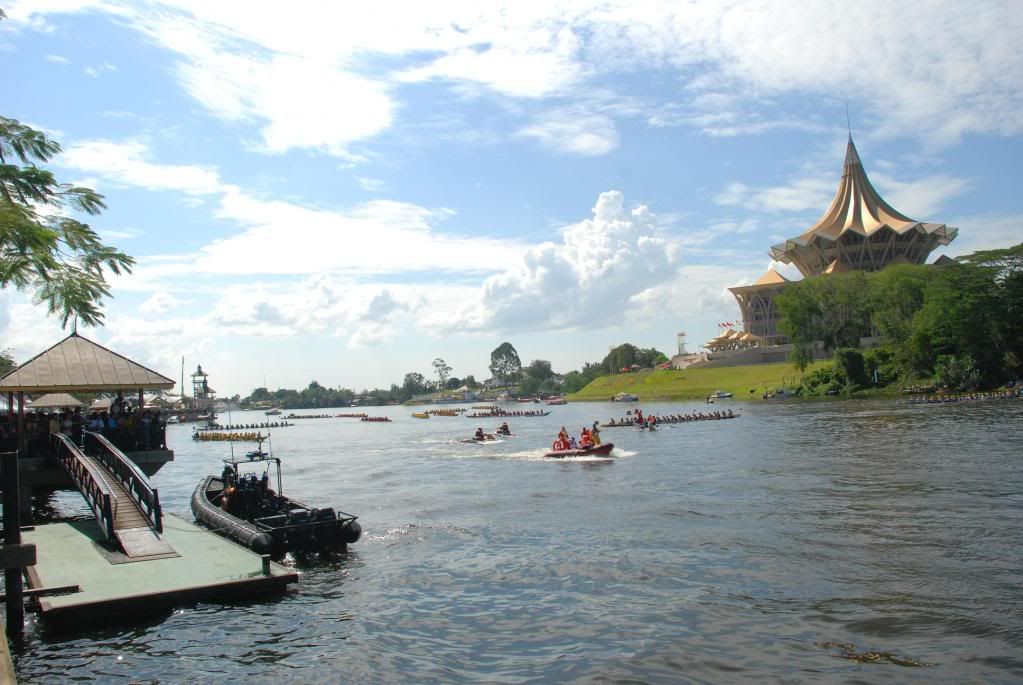
Kuching waterfront, the new golden-roofed State Assembly building on the far bank
In 1842 the territory of Sarawak was small - most of the surrounding land belonging in theory to the Sultanate of Brunei. Over the years, Brooke was able to quell various local rebellions and pirate groups of Dayaks - an umbrella term for indigenous people of Borneo - and gradually annex more of the Sultanate's territory, under the guise of bringing order and prosperity. In practice the Sultan of Brunei was powerless to resist, and first James Brooke then his son and successor Charles Brooke expanded Sarawak relentlessly until 1905, at which point it surrounded Brunei on all land borders.
The following day Hyun and I set out to learn a little about Sarawaks history with a trip to the Sarawak Cultural Village. Established in 1990, this tourist attraction tires to promote and conserve traditional ways of life of the Dayak peoples. In Sarawak, the most numerous ethnic group are the Iban tribe, accounting for some 30%, with the Chinese following shortly behind and Malays around 16%. Other tribal groups including the Bidayuh, Melanau and Penan are left in varying numbers; there last remaining traditional nomadic tribespeople, the Penan, number 300 or so, with the other 20,000 or so settled in villages as per government policy. The traditional dwelling of the non-nomadic tribes is a longhouse - as structure usually elevated on stilts and sometimes over 100m long, where a number of families live together. The longhouses are usually described by the number of doors they have - 30 to 50 being average for 200-500 occupants. Longhouses are still an integral part of life in Sarawak today, albeit looking rather new and shiny with concrete walls, metal roofs and satellite TV.
Many tourists come to Sarawak hoping to have a "genuine" longhouse experience or stay, and hand over good quantities of cash to effect this. The problem is, an authentic longhouse experience nowadays would involve eating some instant noodles whilst watching Malaysian soap operas on a TV turned to maximum volume - anything else is a show.
However, it was wildlife and not longhouses that brought me to Sarawak, and the following day we were off to the first of 6 National Parks that we would visit, Gunung Gading. Although it is the oldest park in Sarawak (started by Charles Brooke) and has a significant amount of primary rainforest, the main reason for the visit was to finally see a Rafflesia flower - the largest flower in the world - one of which was blooming at the moment. Our Rafflesia specimen was a little small (about 2 foot across) but impressive nonetheless. Fortunately it had not started smelling yet - it is pollinated by carrion flies and gives off a powerful stench of rotting meat to attract them. There were a few waterfalls further up the path which made for great swimming spots, excellent after a hot and humid slog up the trail.

Rafflesia flower
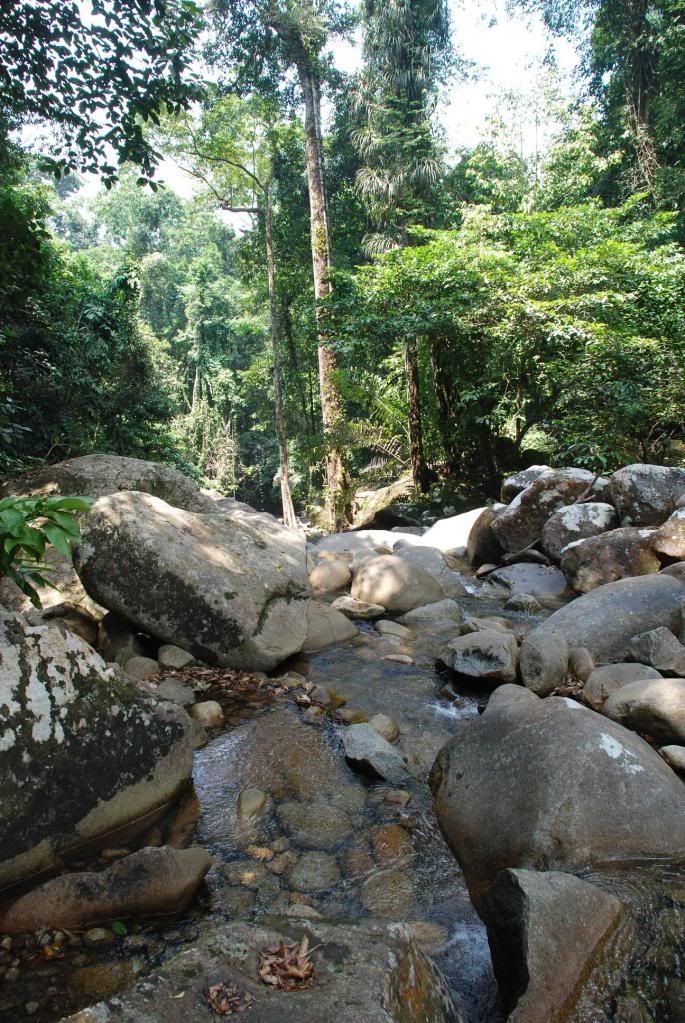
Waterfalls at Gunung Gading
Borneo is also home to orangutans - about 50,000 by most estimates, but their number is shrinking fast. A distinct sub-species from the Sumatran orangutan, it was only right to go and see a few at the Semengok Wildlife centre the next day at the feeding. Semengok has a very similar program of rehabilitation and release as the centre I visited in Bukit Lawang; so far it has released some 24 apes, of whom 4 have never returned to the regular feedings. After hiring a scooter for the day we whizzed over there and enjoyed the morning feeding in a much more formal setup than Sumatra, although we were able to get very close to a mother and baby after the main session had finished.

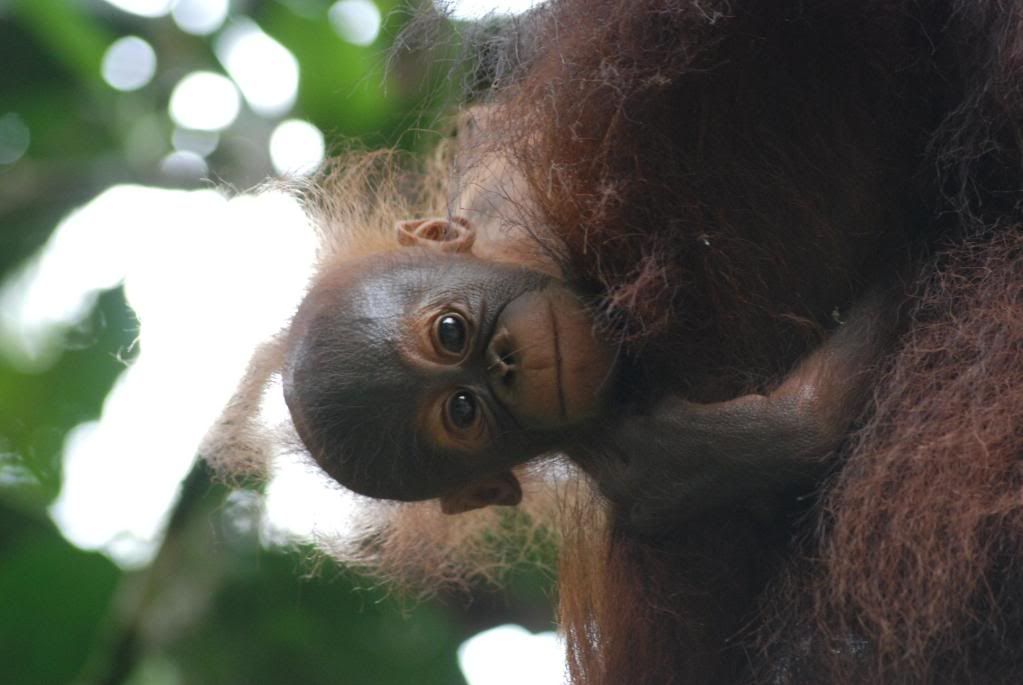
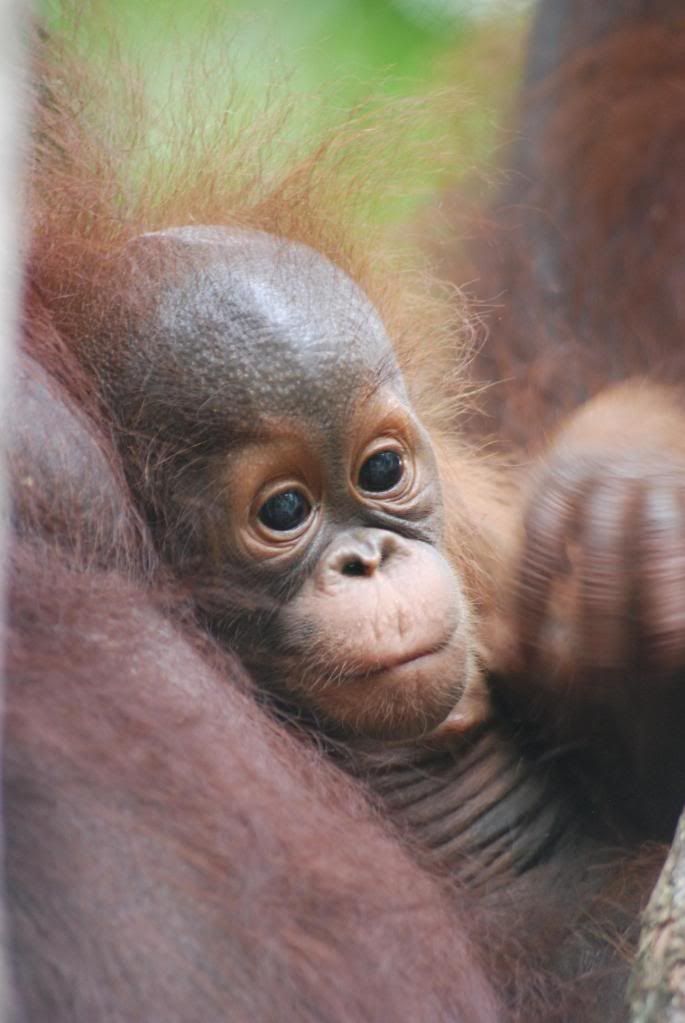
That added extra made us late for our next stop, Jongs Crocodile Farm. Billed as some kind of conservation effort (it was difficult to see how), Jongs had a huge number of wild and captive bred saltwater crocs from the coast of Sarawak. Twice a day they were fed with some fairly choice plucks, and the spectacle of watching the giant creatures leap some 10ft out of the water to grab them from the line was truly impressive. Their largest beast was some 16ft long and had been caught at a local river, although it had not eaten anyone unlike some of it's bethren, which a gallery of graphic photos demonstrated .
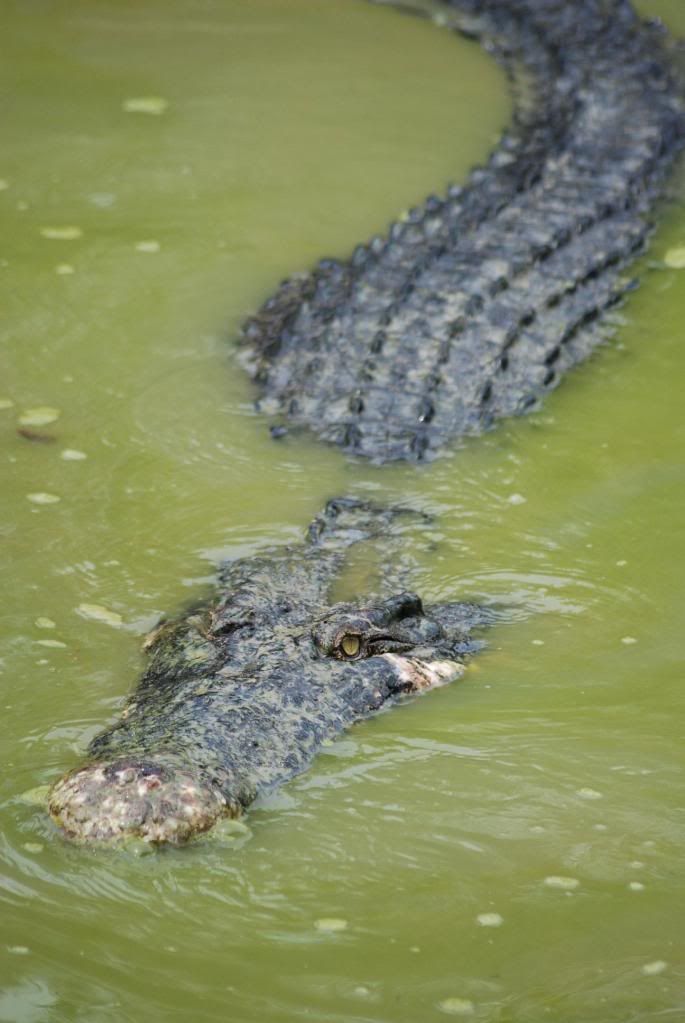
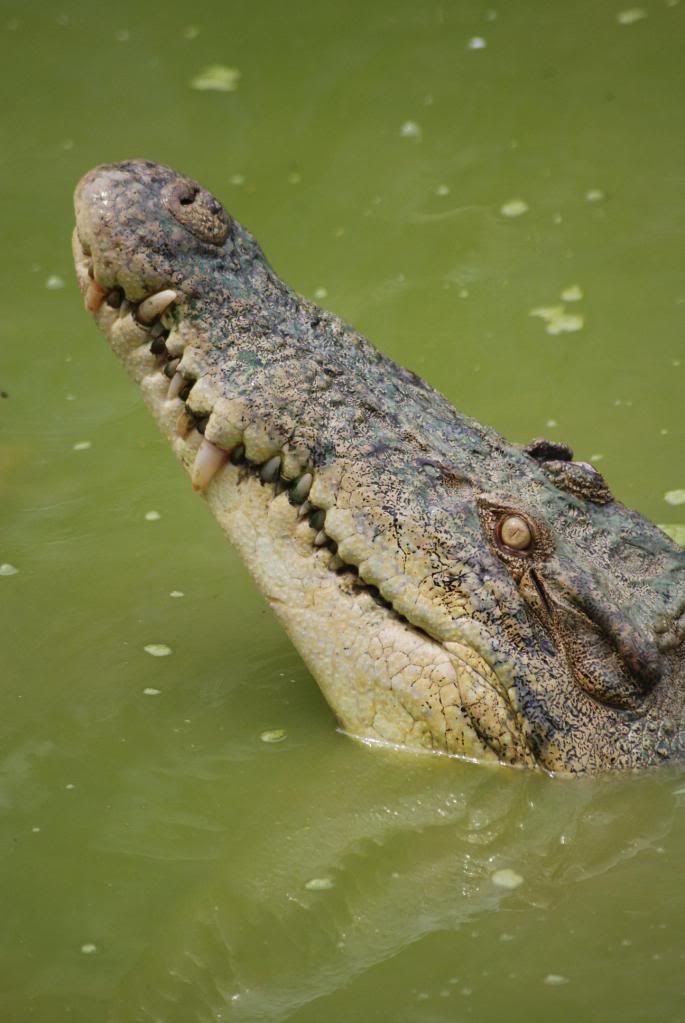
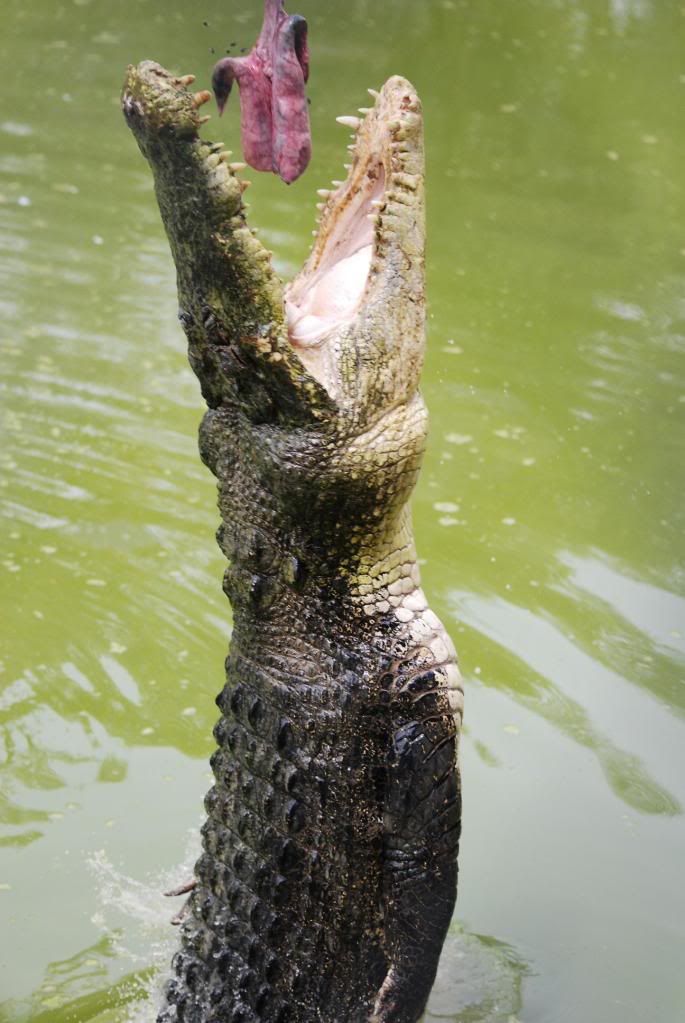
We popped back to Semegok for the afternoon feed and were rewarded with a close encounter with another oranguan as we walked through the arboretum - she seemed not to have a care in the world as she strolled past us looking for fruit.
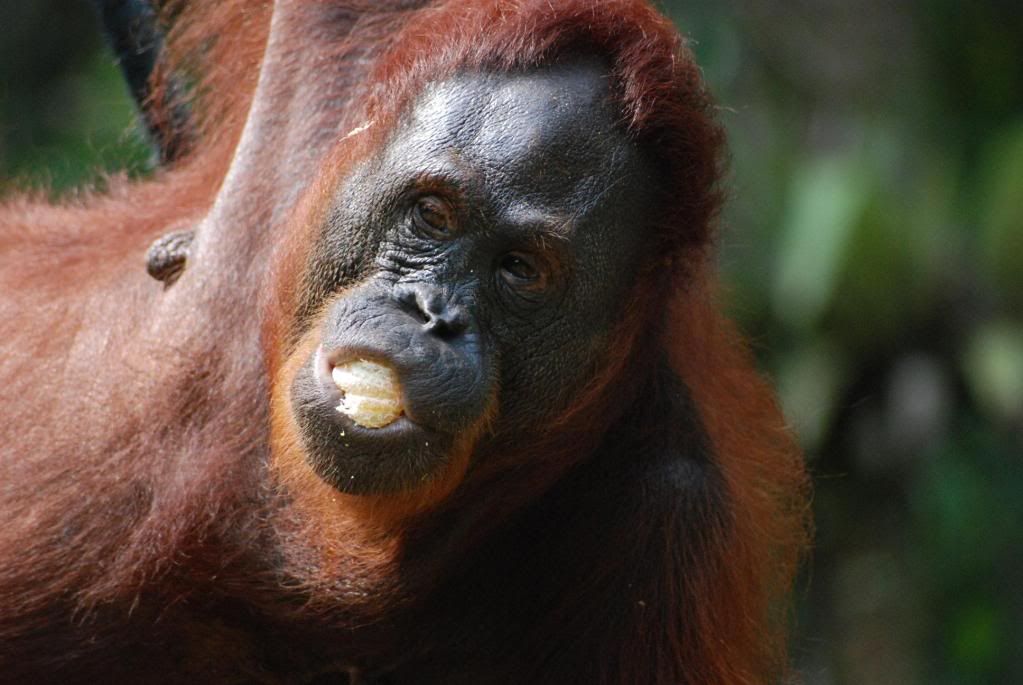
Back in Kuching we made preparations to leave for a three day trip to Bako National Park the next day. We were constantly hounded around the city by the wail of police sirens as motorcades tore up the city. We found out that in a few days the Sultans of all the Malaysian states (including the King of Malaysia) were coming to town in a few days to celebrate the opening of the huge golden-roofed State Assembly on the opposite bank of the river.
The trip to Bako the next day was great, risk-of-crocodiles and falling into the water notwithstanding. Unreachable by road, Bako has a mix of lowland dipterocarp and heath rainforest, as well as a population of proboscis monkeys, endemic to Borneo. We had booked for a couple of nights in the Park HQ accommodation, and set about exploring the local trails to various idyllic beaches. It wasn't hard to spot the wildlife; the proboscis monkeys spent a lot of time around the Park HQ along with bearded pigs scrounging for food and long-tailed macaques who would actually steal food - or anything else left unattended for that matter.
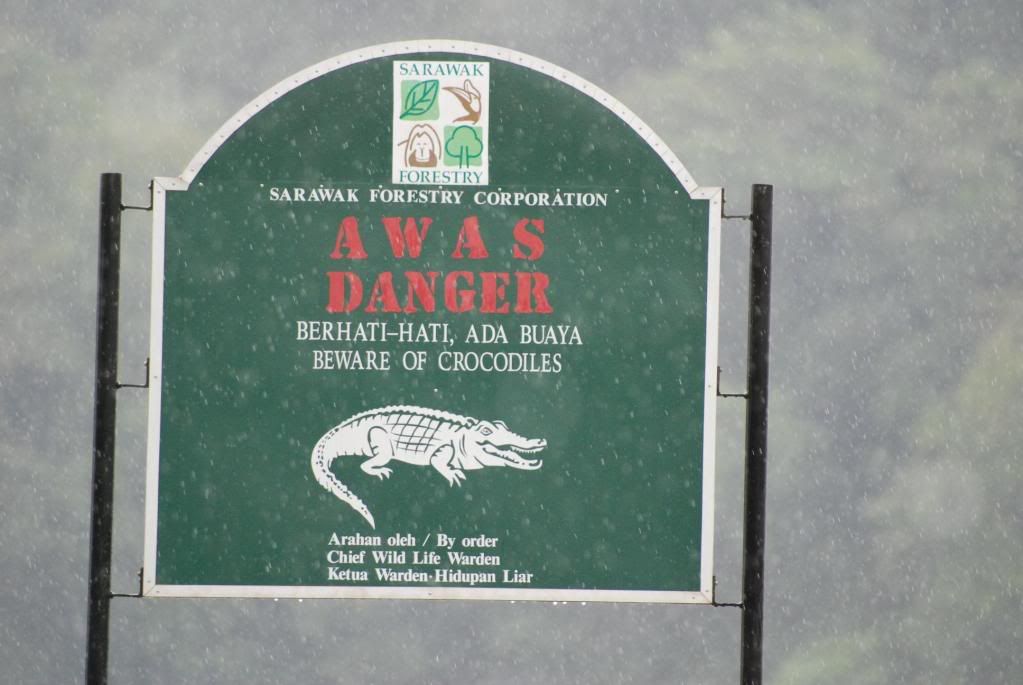

The best beach was Pandan Kecil - a quiet bar of sand, overlooked by huge cliffs of moon-like dark rock and fringed on all sides by jungle. It was just like a jungle beach should be, right down to the jellyfish that gave me a good sting across my shoulder.
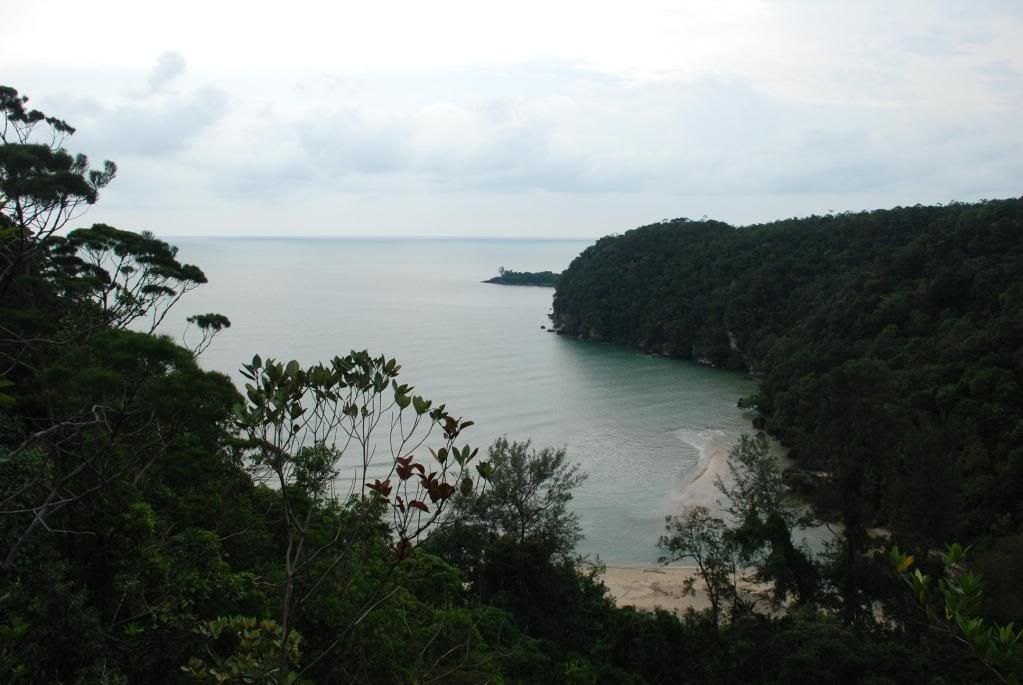
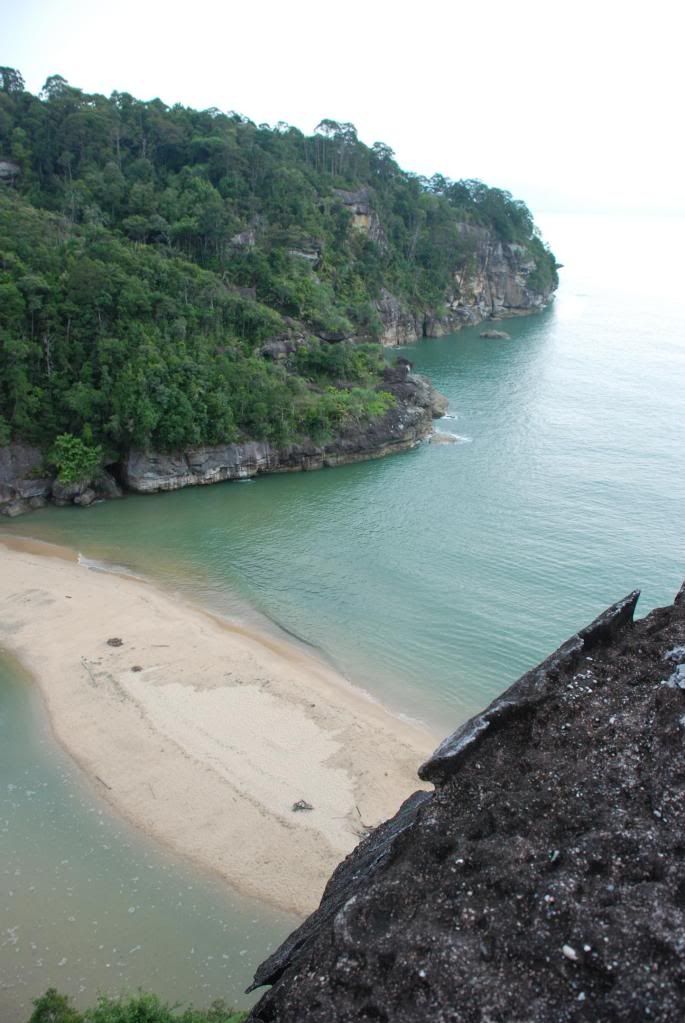
We tried spotting the proboscis monkeys early one morning as they were due to cross a walkway across a mangrove swamp - their regular route. They failed to appear although the boisterous macaques did, who showed no fear in investigating the cameras and one giving me a good pinch. The proboscis monkeys showed up an hour later at the Park HQ, feeding on a fruiting tree as the sun rose, paying no heed of the tourists clustered around with their large collection of SLRs and high-powered zooms.
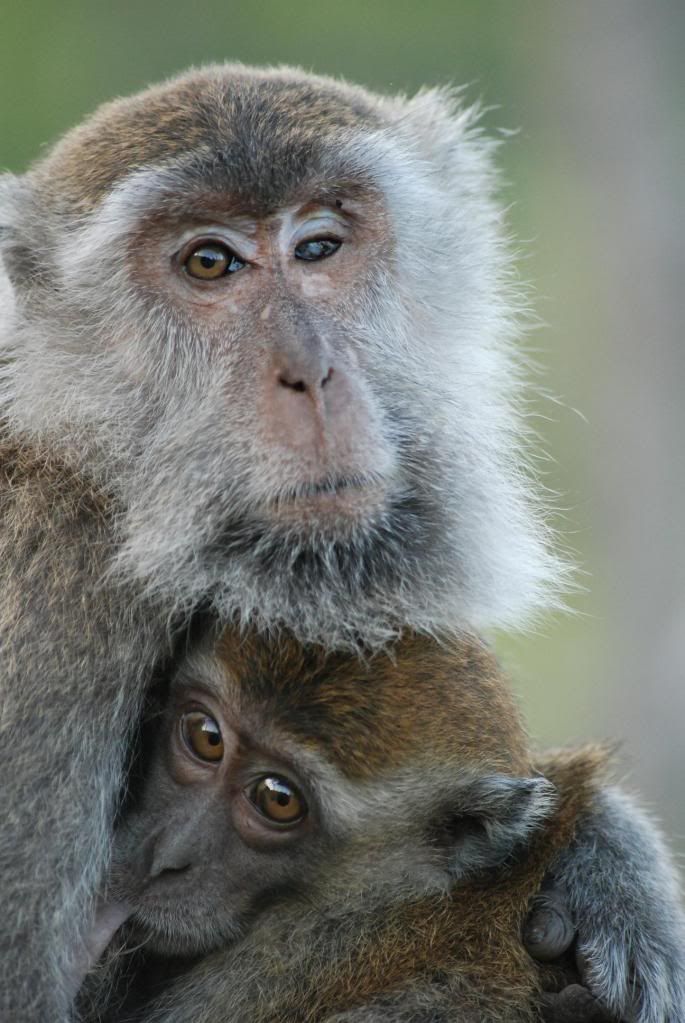
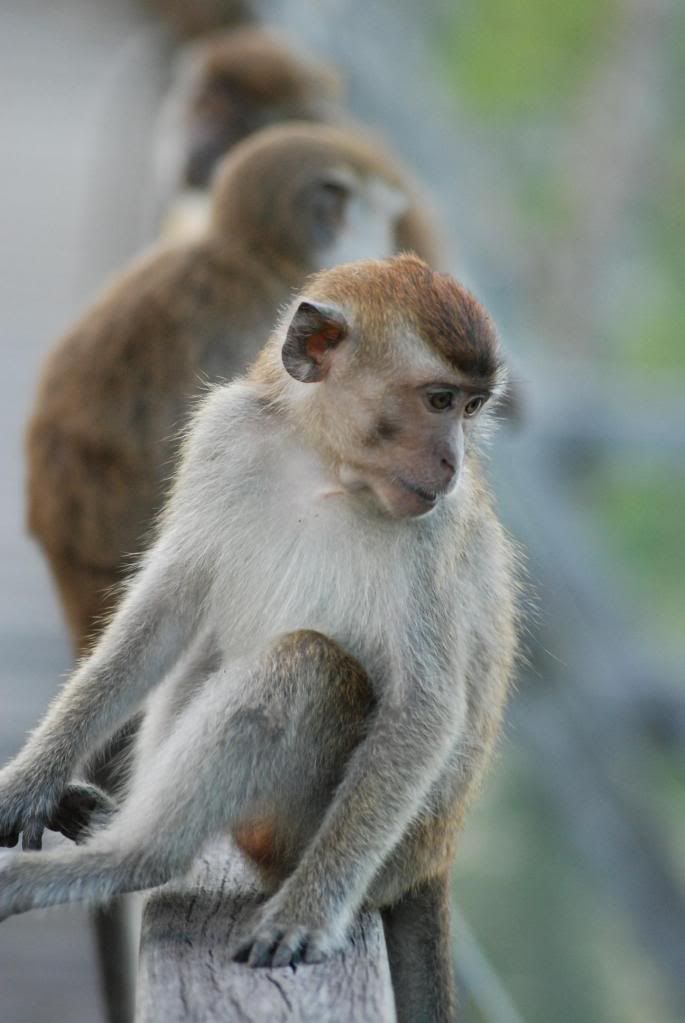
Macaques
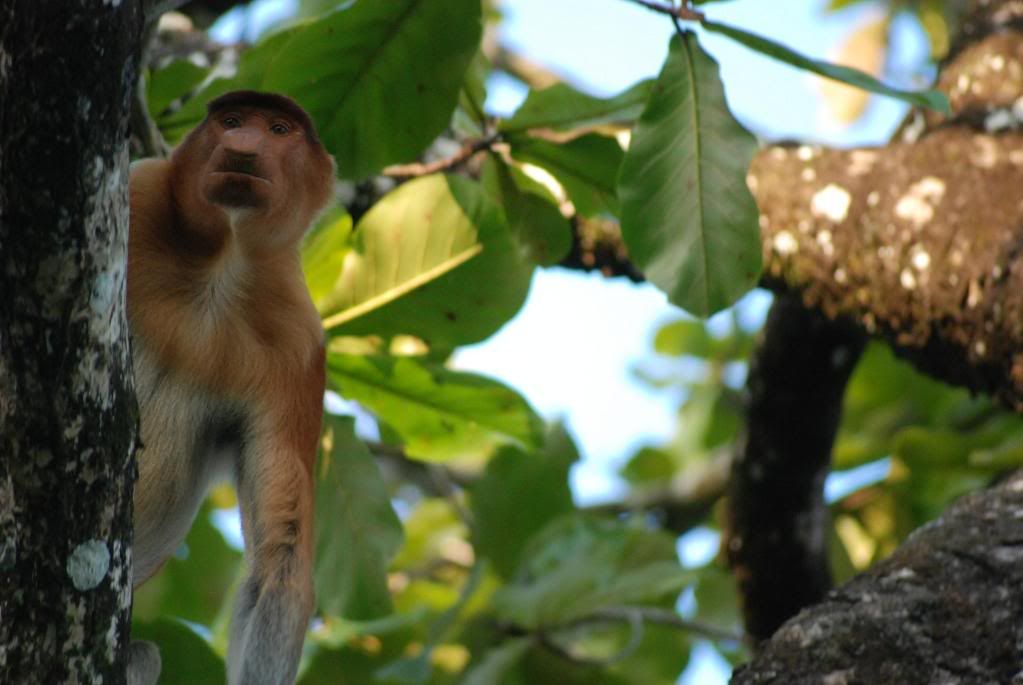
Proboscis monkey
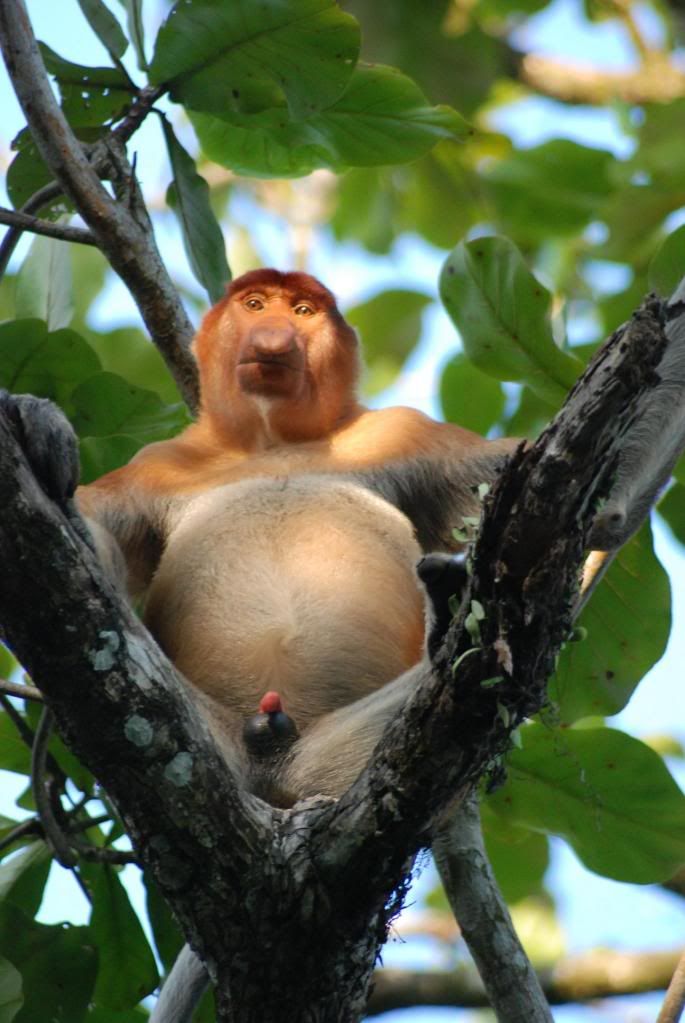

Sunset at Bako....

...and the hermit crabs come out
Back from Bako we went to a concert - the first event celebrating the big opening of the assembly building. As the stars of Academi Fantasia (read Pop Idol) wailed out their latest hits (and I do mean wailed), the satay stalls nearby were by far the most exciting thing and sufficiently removed from the action to not risk aural damage.
The following day was a little more of the same and somewhat frustrating - being a Sunday most things were closed, including the Tourist Office, National Parks Office and motorbike rental places. We settled for a stroll along the increasingly busy waterfront, by now set up for a huge regatta the following day and teeming with all kinds of armed police on boats, bikes and jetskis. The constant noise of the motorcades as they swept imperiously around town added to the atmosphere, although by evening time it was strangely quiet as we crossed the river to enjoy some pansuh, a traditional dish slow-cooked in bamboo over a fire. That was disappointing: the bamboo used only to serve the pansuh in - it was probably stewed for a couple of hours in a large steel pot - and consisted of chicken (mostly bone) and a wide variety of inedible "jungle roots and ferns".
The carnival atmosphere came into it's own the next day, and we spent an hour standing in the sun awaiting the arrival of the King and various Sultans. We were well placed right by the red carpet where the armoured limousines would pull up, and I shook hands with at least one "important" person who nobody seemed to know. The main player of the day, the King, was a no-show as he decided to sleep in (it was past midday), but the other Sultans appeared, some of whom I could even recognise from the photos patriotically displayed in most businesses. The regatta started once all the royalty who were conscious had arrived, and there followed several dragon boat races up a rather choppy river. These races were great, not least for the fact that in every race at least one boat, overloaded with paddlers, would start to sink. That night the waterfront was incredibly busy with people seemingly just hanging around - we escaped back to the hostel and only re-emerged when a huge firework display lit up the sky around the new assembly building.
The following morning we turned our backs on Kuching and took a fast boat to Sibu, northeast across a bay of the South China Sea and then upriver some 60km. Our plan was to get to Kapit, a small logging town further upriver, and then from there get up to Belaga, an even smaller place about as far away from it all as you can get in Sarawak. The boat ride to Sibu was fast and efficient, and we transferred almost seamlessly to an express boat heading the 125km upriver to Kapit.
The express boats that ply the waterways of Sarawak are precisely that; very fast, resembling an aeroplane without wings, with a comically huge engine in the back and huge exhausts belching volumes out the back in an effort to get people where there are no roads. We arrived in Kapit as the sun was setting, found a hotel and a pasar malam (night market) with excellent food.
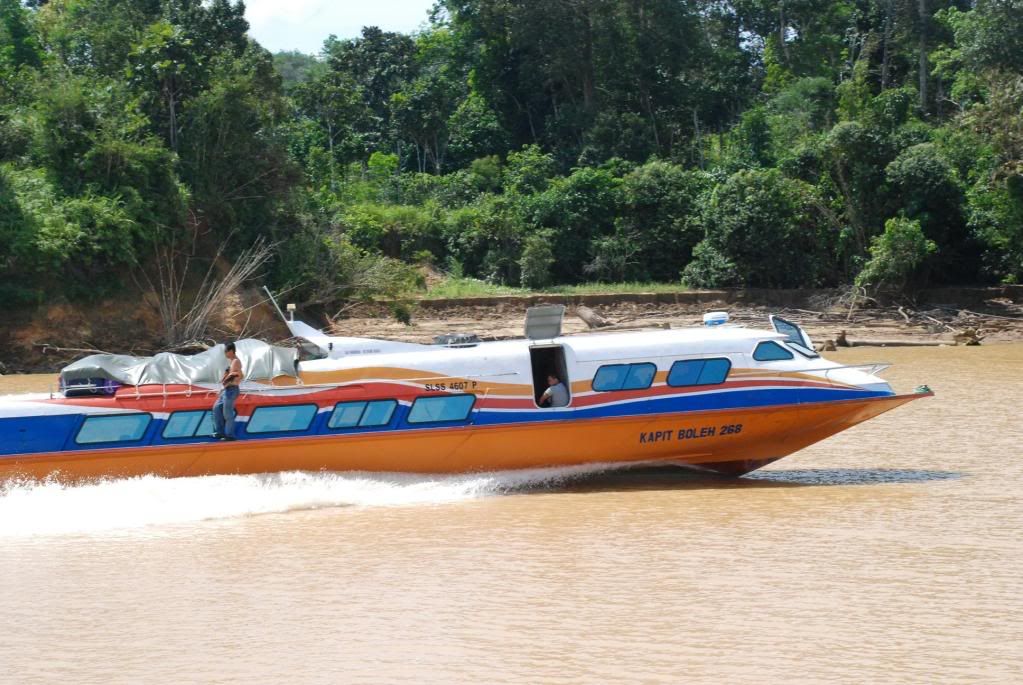
Express boat.... missing the wings needed for takeoff
Sibu, Kapit and Belaga are the main towns people visit for their "longhouse experience". Cynical as Hyun and I were of a genuine experience with financially motivated origins, we had decided to head up to Belaga by boat, and then go back to the coast by logging road to Bintulu, some 3 hours northeast Sibu by paved highway. We figured the journey would be experience enough..... but in order to get to Belaga, we had to get permission first.
Kapit is in the odd position of being unconnected to the outside world by road, but with some 4000 cars competing for 400 parking spaces on it's small amount of paved road. We got a lift to the Residents Office in the government building, a vast, 10 storey concrete and glass tower block that was as out of place in Kapit as it would have been had they built it in the Masai Mara. However, we were duly issued with permits for visiting Belaga, along with a few raised eyebrows and mutterings along the line of "You haven't a hope in hell".

Kapit - lots of cars with nowhere to go
Armed with permits we asked almost everyone with a boat if they would take us to Belaga... the answer was a resounding negative. Kapit lies on the Rejang River, and upstream was the mighty Pelagus Rapids which are impassable at the moment. Despite the best efforts of the British Army and a lot of dynamite in the 60's, the rapids are still only navigable when the water is high and you have a very powerful engine. We were fast becoming aware that not only was this the dry season, it had also been very dry, and passing the rapids was impossible. We headed back to Sibu with a wry grin.
On the boat to Sibu we met a few local Iban lads, who seemed very keen to take us back to their longhouse and ply us with beer. This could have been the "genuine" experience we were after, but not long after they were all asleep and we were left watching the modern longhouses that formed most settlements on the Rejang and the endless timber barges running downstream to the plywood factories.
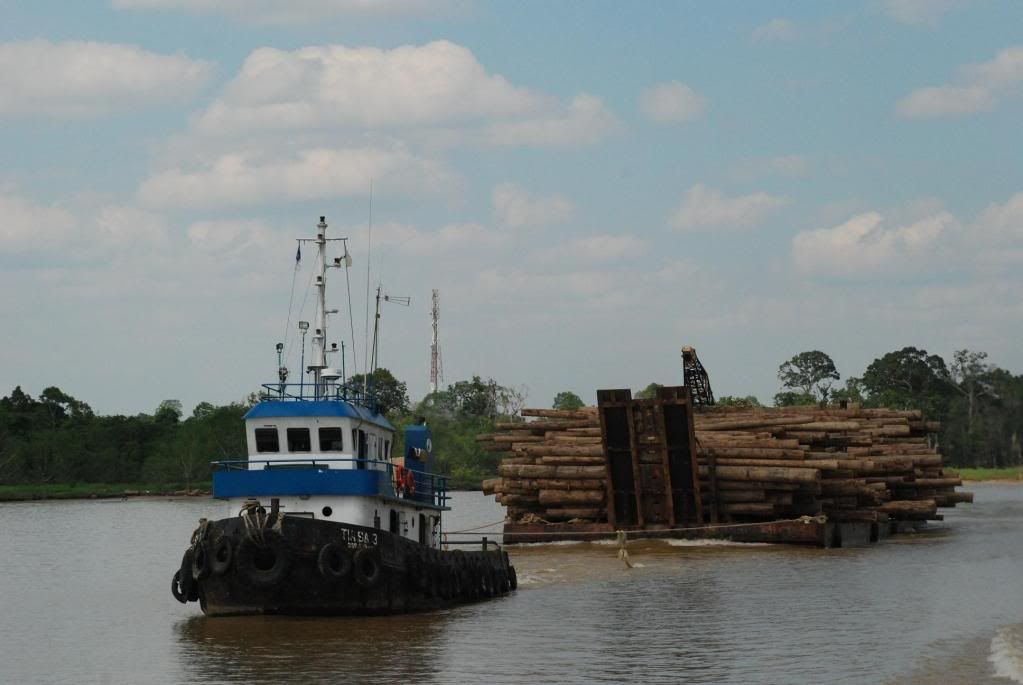
One of the many timber barges
If you've ever wondered about the statistics involving deforestation of rainforest, you only need a short trip along the Rejang for those soundbites to become a cold reality. "An area the size of Wales every year" or "six football pitches every hour" becomes a little hard to visualise, but seeing barge after barge after barge loaded with timber, and seemingly endless factories churning out plywood from vast lumber yards, was a thoroughly depressing and humbling experience. There may be controls in place but believe the quotes, they are true - the rainforest is disappearing and at a rate you cannot imagine.
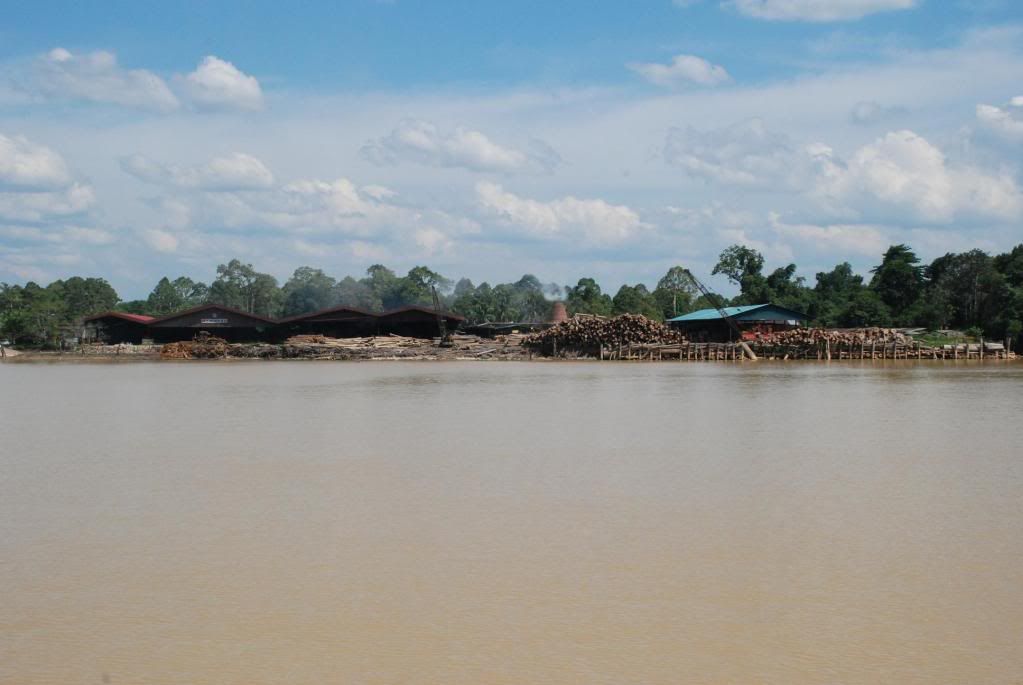
Plywood factory on the lower Rejang
Back in Sibu, barely 24 hours since arriving, and our Iban friends scarpered off the boat leaving us to get on a bus and carry on northeast up the coast. The next stop was Bintulu, a town booming fromboth a huge LNG reserve found offshore (Malaysia's largest reserve) and timber. It was not, in any way, shape or form, set up for tourism. After a staggering unsuccessful attempt to find a road full of good restaurants (it was only 40m from our hotel, but no-one knew that), we tried the following day to visit Similajau National Park, a coastal strip home to nice beaches and nesting turtles. It proved impossible to find a bus there or a motorbike to hire, and we gave up and had a relaxing day wandering around town, eventually finding the restaurant street ourselves, plus a small funfair for some evening entertainment to boot.
The following day we headed up to Niah National Park, another couple of hours northeast along the coast. We had booked a couple of days to explore the vast limestone caves there that are a feature of eastern Sarawak. The caves are so huge due to the very dense limestone found in the area - it allows for large caverns to develop but water dissolution/erosion whilst not collpasing. Niah was famous for a few of reasons. First was the bats - some 500,000 live in the the main Great Cave, and leave each night to be replaced by the second natural wonder - some half a million swifts that also call the cave home. For several hundred years the caves and their contents have been exploited - the bat guano has been mined, and the swift's nests are collected for birds nest soup.
The caves became of archaeological importantance in 1963 the Curator of Sarawak Museum found a human skull some 40,000 years old, forcing a total rethink of hominid occupation of island south-east Asia. There are a couple of hundred identified grave sites within the great cave, and within a smaller cave are the oldest cave paintings in Borneo, estimated at some 3,000 years old.
Hyun and I decided to save the below-ground for the following day, and headed on the only above ground trail to scale the heights of the limestone cliffs in which the caveas are found. It was a very steep 200m climb - a lot of it on ladders - but the view from the top was well worth it.

The next day we headed over to the caves in the afternoon, hoping to see them all and then the "changing of the guard" - when the bats left at dusk and the swifts returned to the cave. The caves were huge, awesome structures; in places roof collapses had left windows of daylight that played down into the cavern casting eerie shadows over boulders. There were a huge number of ladders and poles affixed to the roof to allow the birds nest harvesters to work. The job involves an incredibly risky climb up the poorly supported poles to the roof of the cave, where twice yearly the workers are allowed to takes nests and harvest the glutinous secretions that both bond the nest together and go into making the soup.
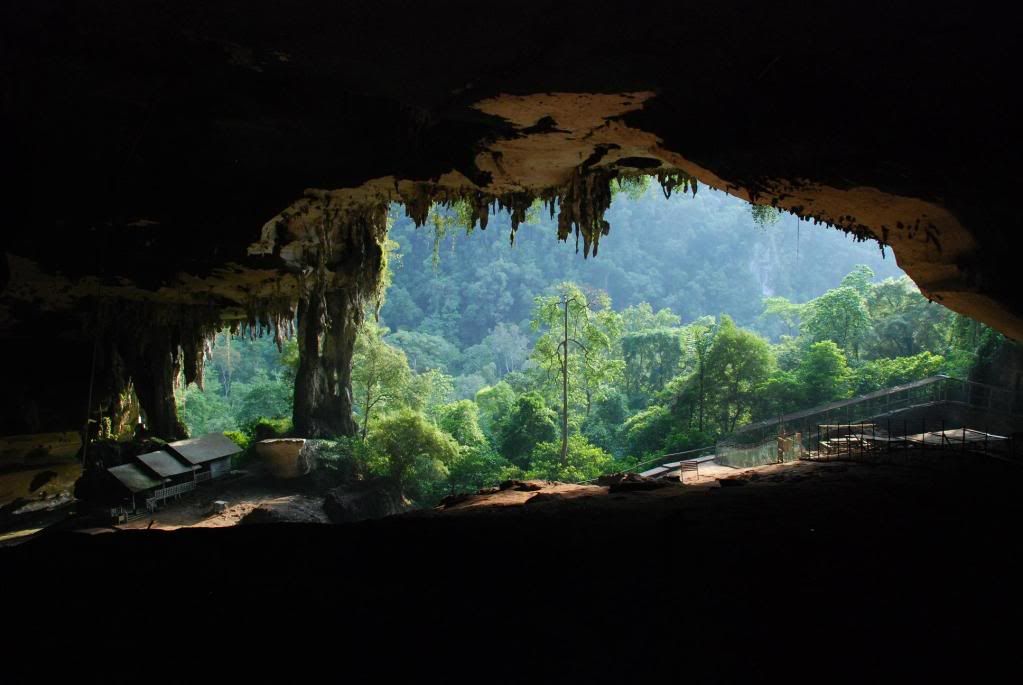
West Mouth of the Great Cave
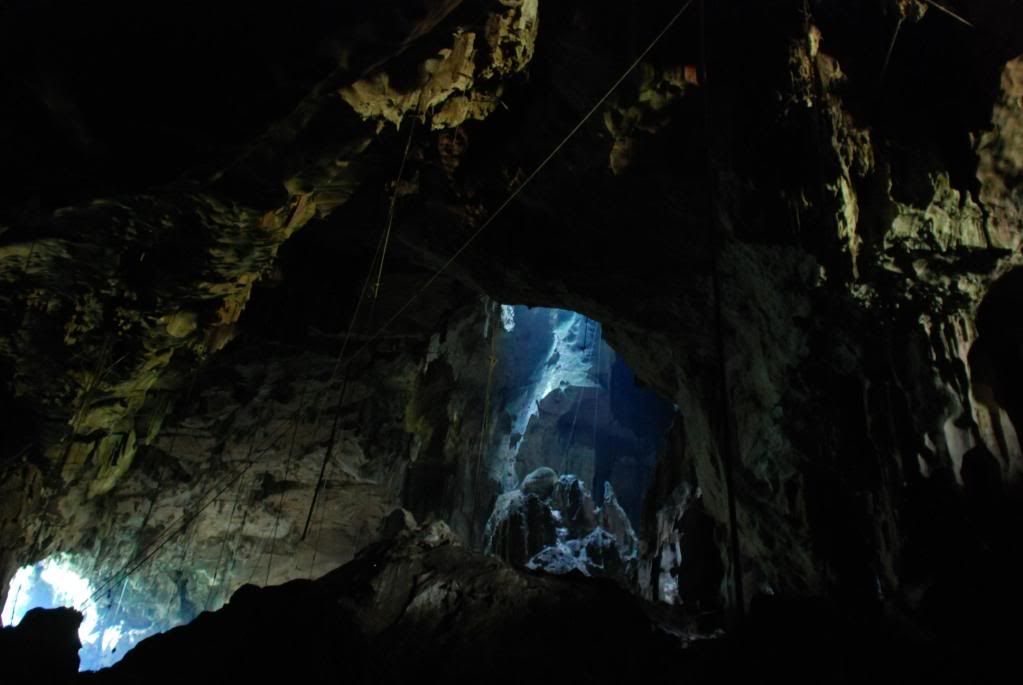
Inside the great Cave - the hanging things are all poles for the bords nest harvesters
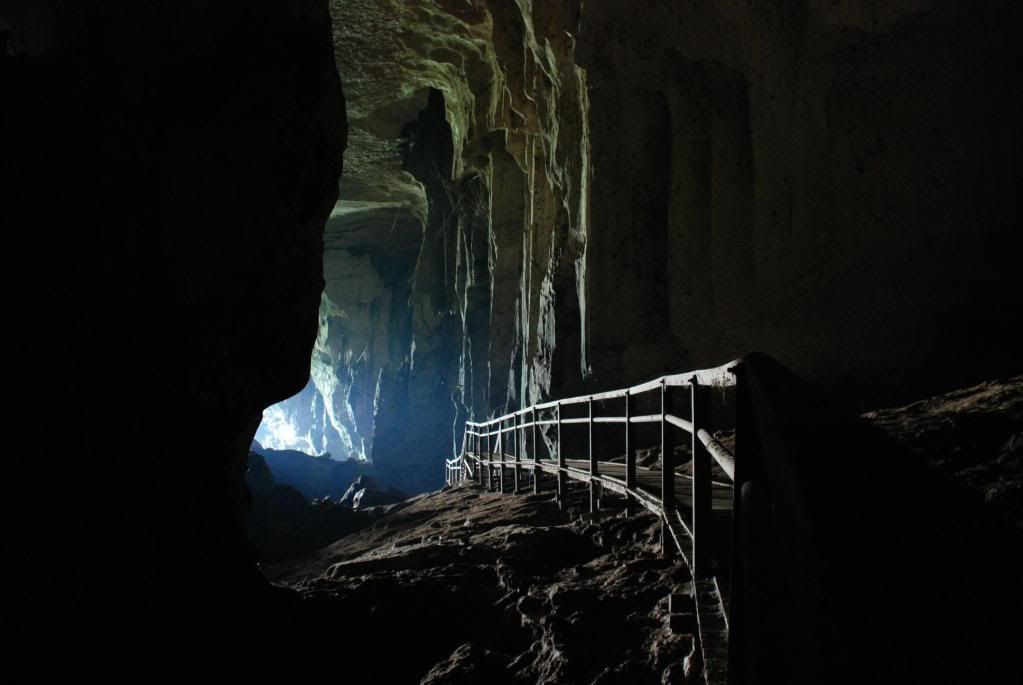
The paintings in the so-called "Painted Cave" were disappointing to say the least, protected by layers of fencing and barbed wire, but the pitch-black cave walk to get there was fabulous fun, though Hyun and I reflected that if we had each been alone it would have been just a little scary. We got back to the West Mouth of the Great Cave just before sunset, and sat down to watch. There was a steady stream of bats but not a huge number; at one point a bat hawk flew in to take a few easy pickings, and we left in total darkness wondering what all the fuss had been about - we saw pretty much nothing.
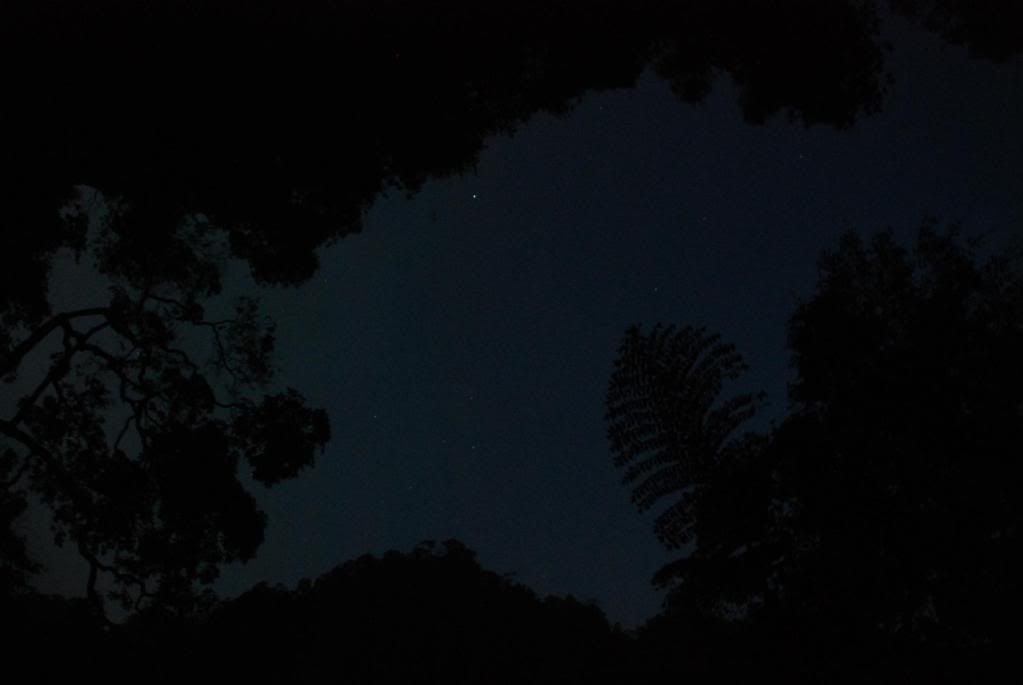
The Great Cave mouth by night.....
The following day - a Sunday - we arrived in Miri, our last city in Sarawak from where we intended to do some diving and visit a couple of National Parks. To cut a long story short, we spent the next 36 hours trying -and failing mostly - to sort out an independent trip to Gunung Mulu National Park. Everything was fully booked or close to being so - flights were full, accommodation at the Park was full, activities in the Park were full. We eventually bagged a couple of flights and tried to book a tour; when that failed, we had a stroke of good luck and picked up a room after a cancellation just hours before.
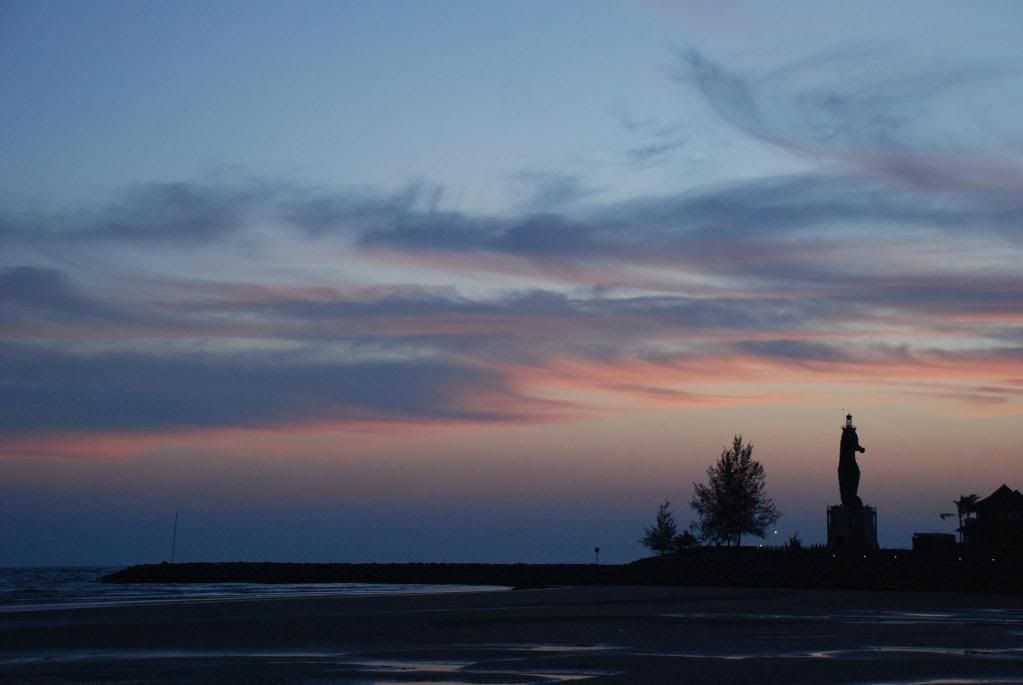
Miri lighthouse... or seahorse.....
Gunung Mulu NP is famous for it's limestone scenery - both vast cave networks and a series of limestone prominences, the Pinnacles, that make Malham Cove's karst scenery look decidely second rate. We knew that the Pinnacles trip was fully booked but assumed visiting the caves, canopy walk and other attractions would be easy... but first we had to get there.
We organised a brief day trip to another local National Park, Lambir Hills before heading to Mulu. Lambir Hills boasts the highest biodiversity per hectare identifed anywhere in the world, with a bewildering mix of tropical rainforest types. We went for the waterfalls and swimming to be had, although in the current drought they were reduced mainly to a trickle, and the views were obscured by an everpresent haze of smoke drifting from myriad fires over the border in Kalimantan.

Arrival, eventually, in Mulu
The following day the Mulu trip started well, at least. The flight in a large Twin Otter turboprop left about on time, but on descent to Mulu airfield the haze was too dense to see the runway with any degree of safety, and we headed back to Miri with another wry grin and wondering if the Mulu place was really worth the bother. MAS Wings, a division of Malaysian Airlines, did a sterling job and whilst I waited to get our baggage back Hyun got our replacement flight tickets for the following day - scheduled earlier to avoid the haze - plus accommodation in the local country club, complete with Olympic sized swimming pool. We had to take that one on the chin.
The following day, after 2km in the pool and a rather large breakfast, we were back on a Fokker 50 turboprop flying to Mulu. The haze semed identical but the pilot landed anyway, and we installed ourselves in a pleasant room at the Matumau lodge - a full board lodge with just a few rooms. Within an hour or two we had figured that many of the activites in the Park - run by a private business and charged in that way - were full. We eventually settled on a program taking in all the large "show" caves, plus short caving trip, a night walk and canopy trip. Part of the issue in Mulu NP is that there are not enough guides in peak season to cater for the numbers of tourists and trips fill up rapidly; there are very few trails to be walked independently as this would mean a loss of income for both the Park business and the local Penan villagers, many of whom are employed within the park.

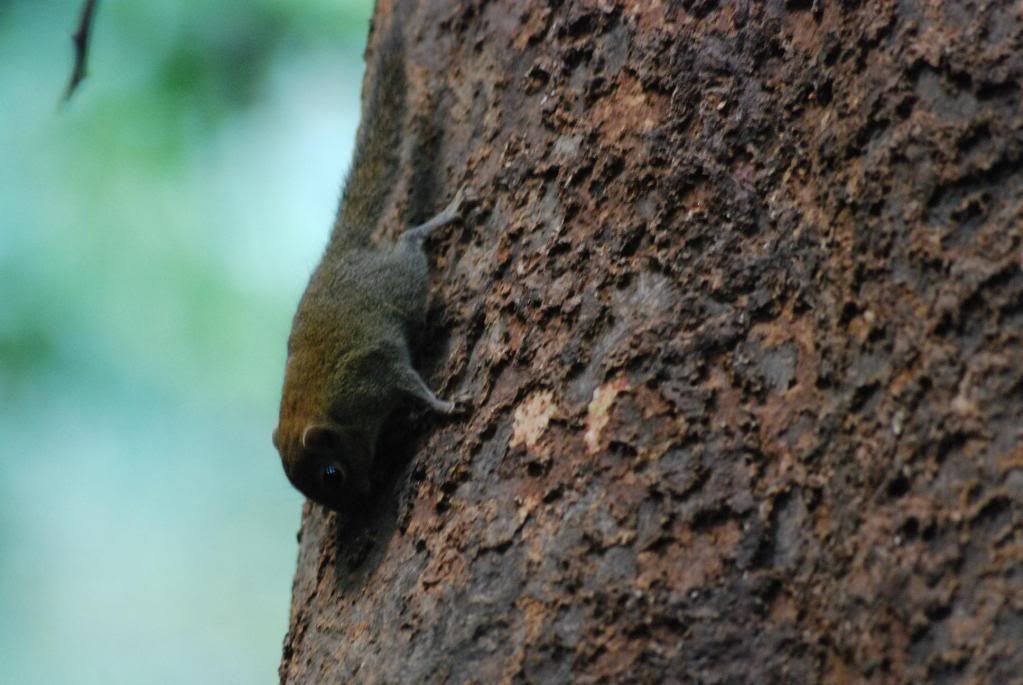
Pygmy squirrel
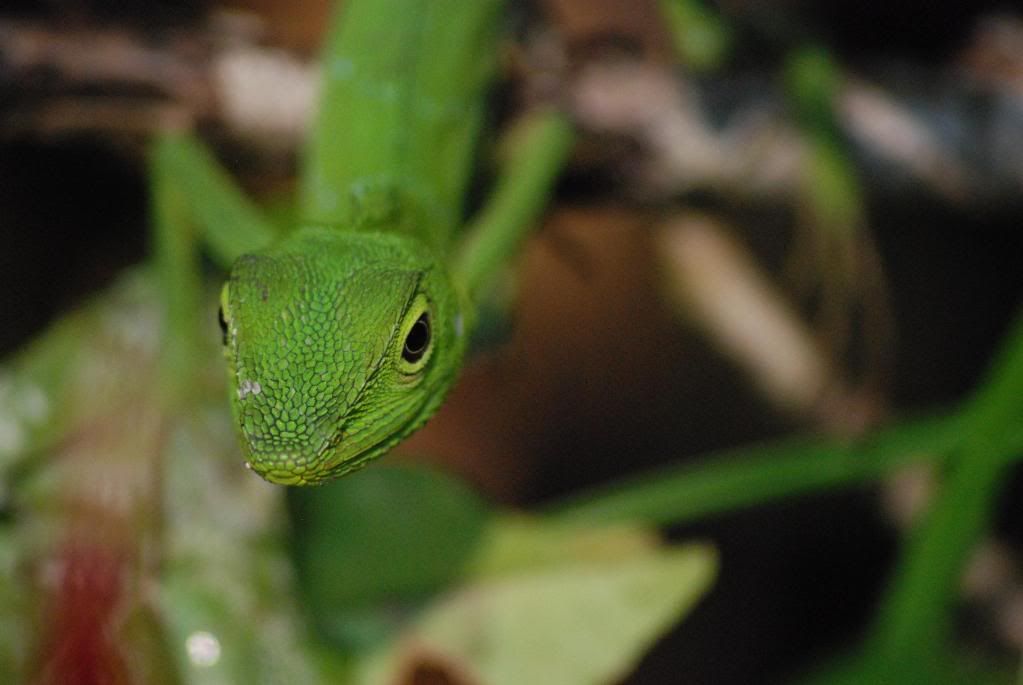
Mulu boasts the largest cave chamber in the world - the Sarawak chamber - but this is unreachable except on a rather extreme caving trip. Instead, we did the one '4-5 hour' self-guided trail in the Park - it took 2 hours for the roundtrip and finished at a pretty sorry looking waterfall. Here as well the drought was clearly evident, from low water levels to wilting leaves. Afterward we visited the Deer and Langs Caves as part of a huge group, led by a guide who walked far too rapidly - we never saw her after we reached the cave. Langs cave was beautiful but the Deer cave and it's passage through to the Garden of Eden was awe-inspiring - it is the largest cave passage in the world and home to 2-3 million wrinkle-lipped bats. After leaving the caves we stopped at the "Bat Observatory" to watch the bats leave at dusk - groups of 100,000 bats would leave in a dense, heaving spirals, one after another. Niah paled in comparison.
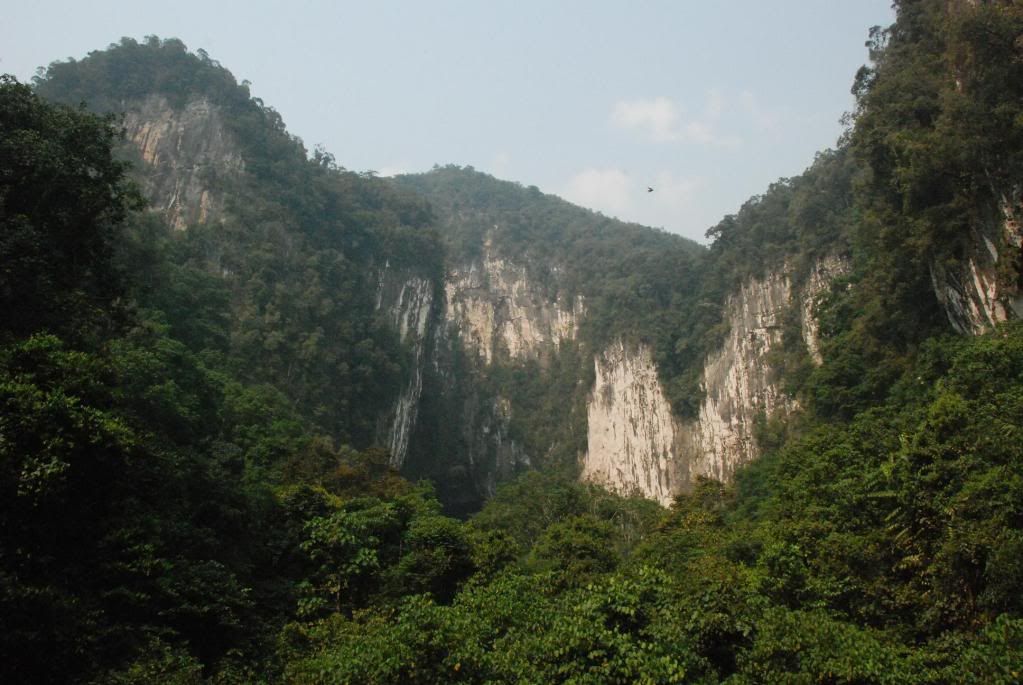
Malham Cove, but with jungle. And caves. And much, much bigger.
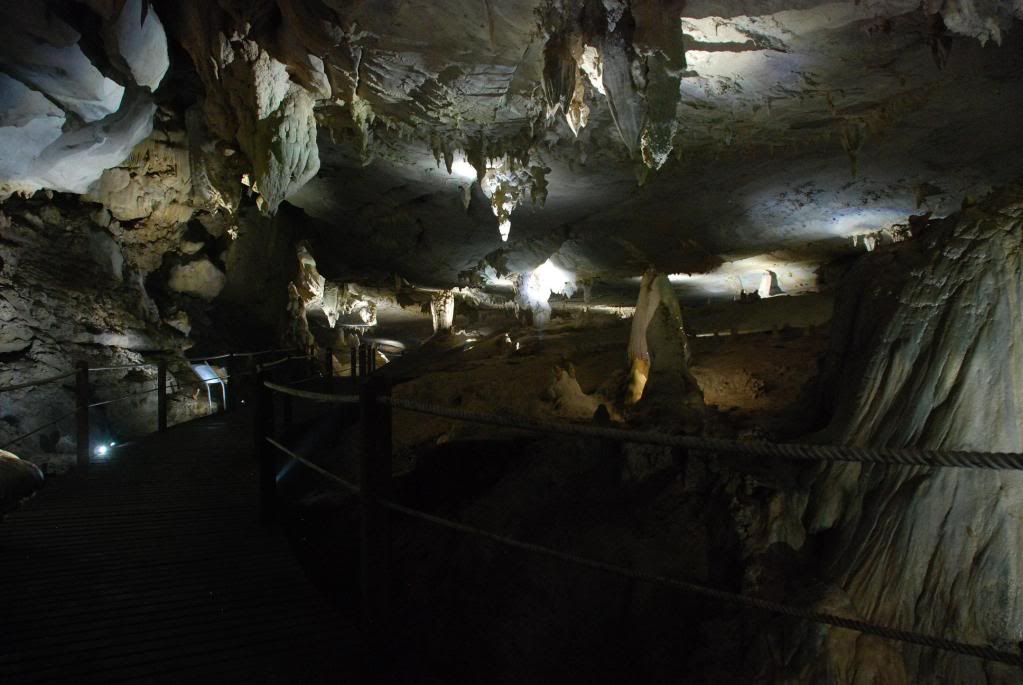
Langs Cave
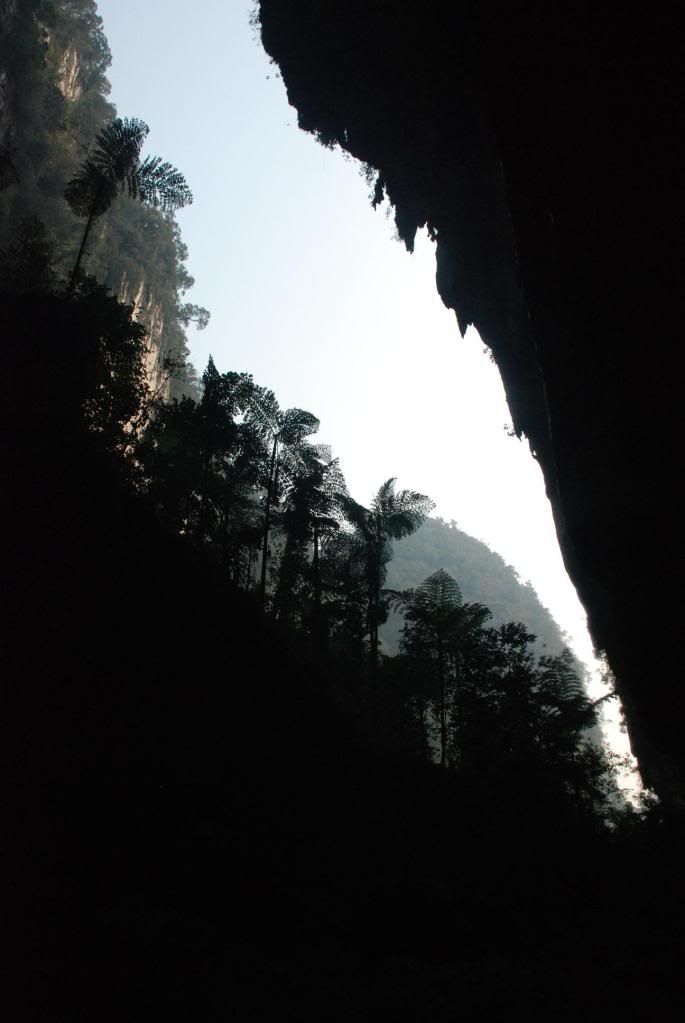
Heading into the Deer Cave
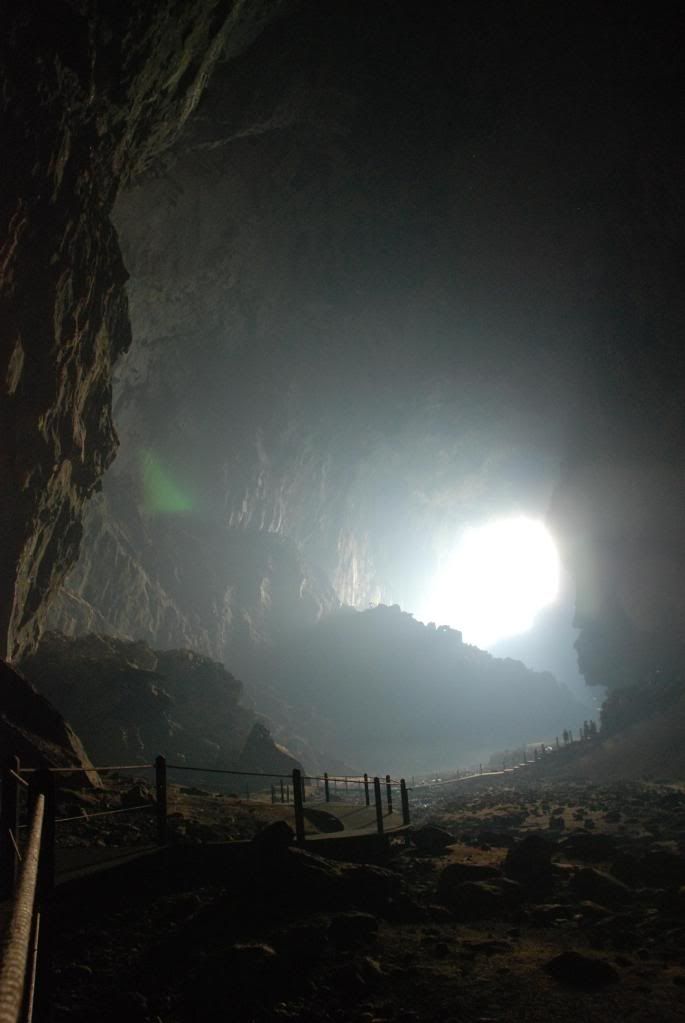
Deer Cave entrance
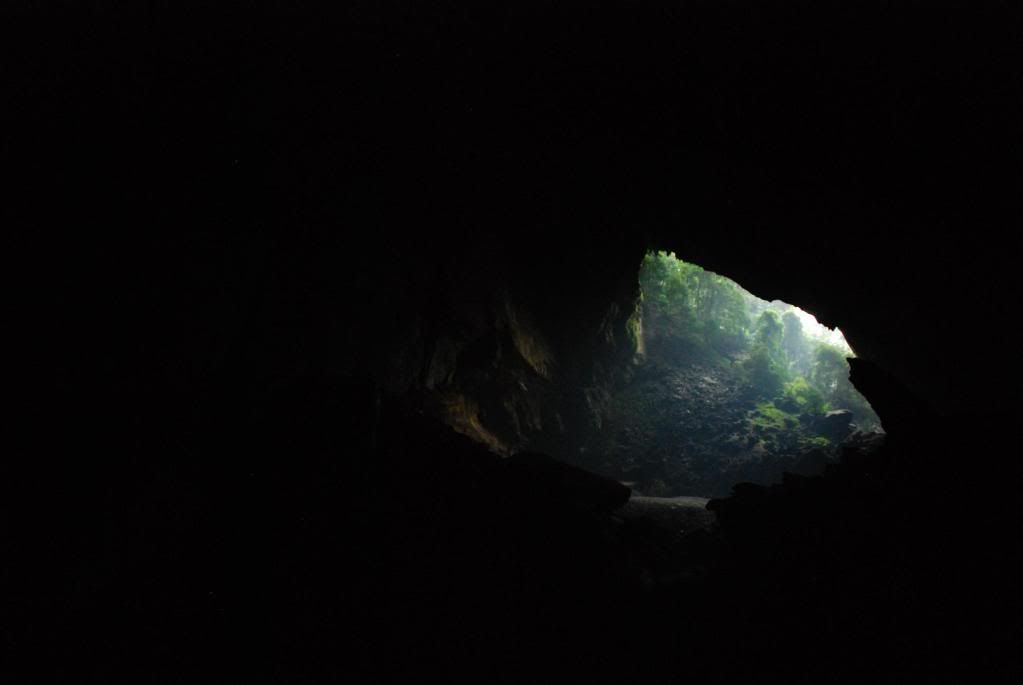
The Garden of Eden
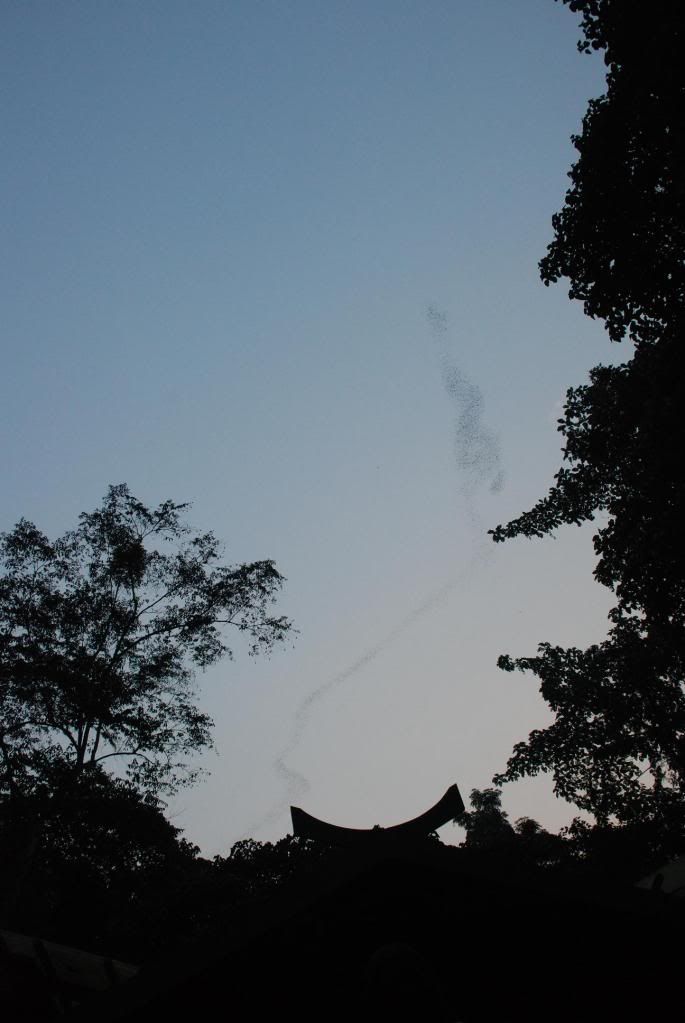
Bat exodus
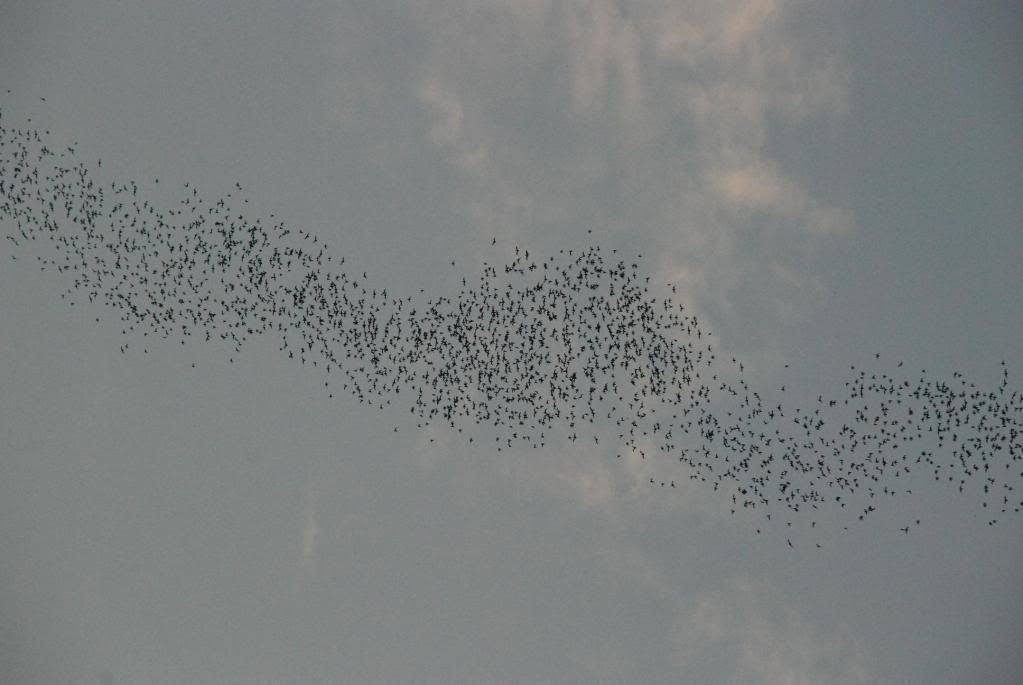
Bats! Count 'em.....
We filled the rest of our time at Mulu visiting more show caves and shelling out for trips that we could easily done ourselves - except our brief adenture caving trip. With all longer trips fully booked we had a 1 hour explore of Turtle cave that was great fun - just ourselves with a guide, scrambling and swimming through tunnels exploring small spaces and even being allowed to try and find the way ourselves briefly (my sometimes infallible sense of direction did not work underground).
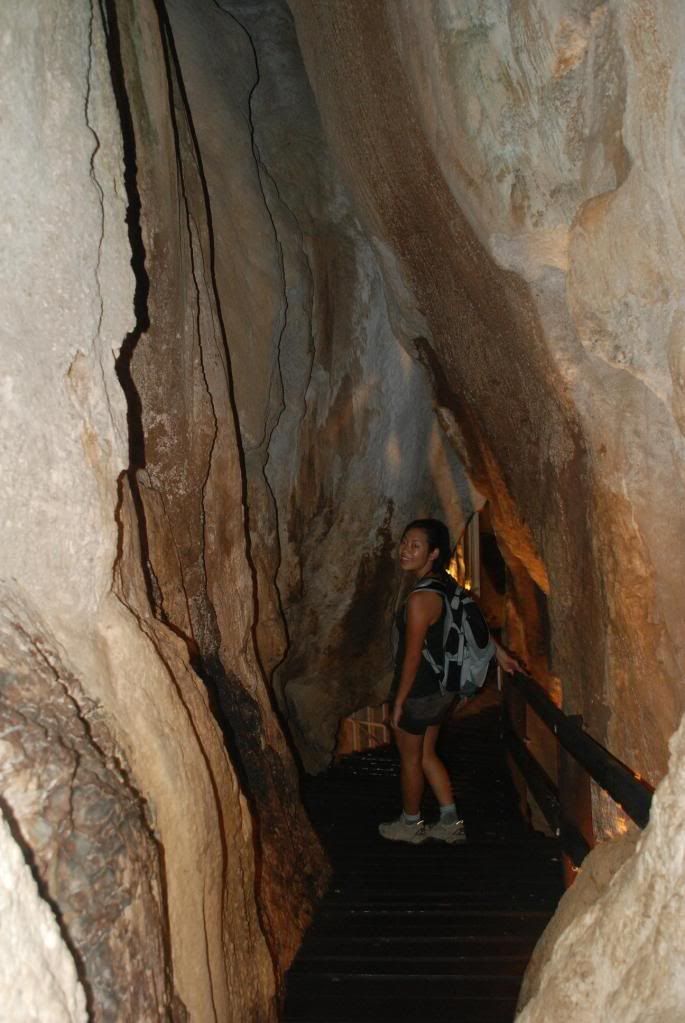
Hyun in Wind Cave
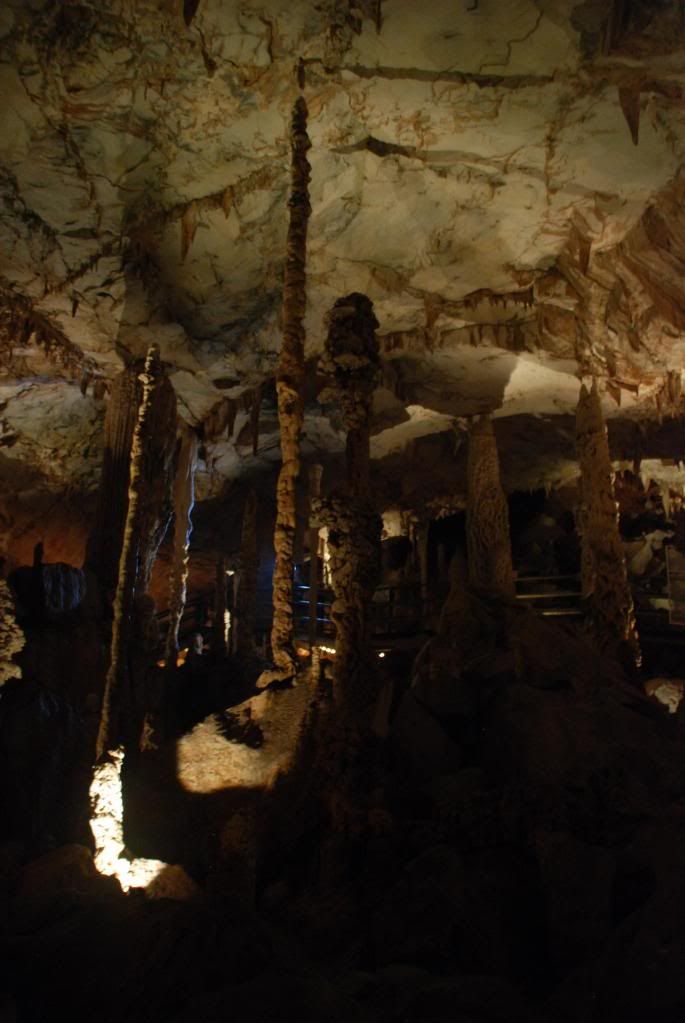
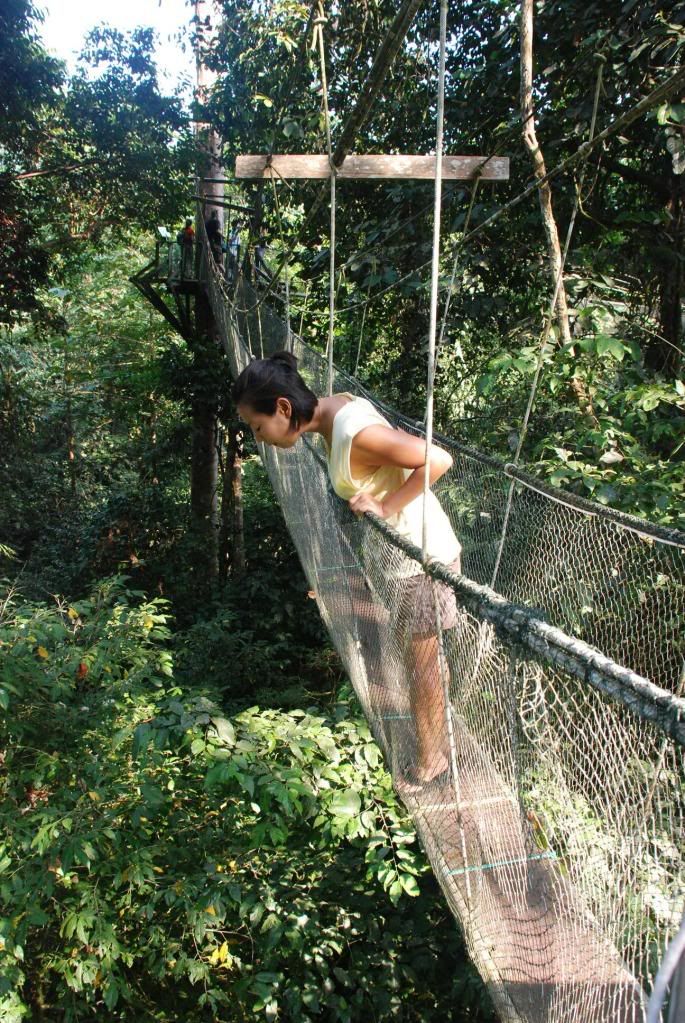
Fearless on the canopy walk....
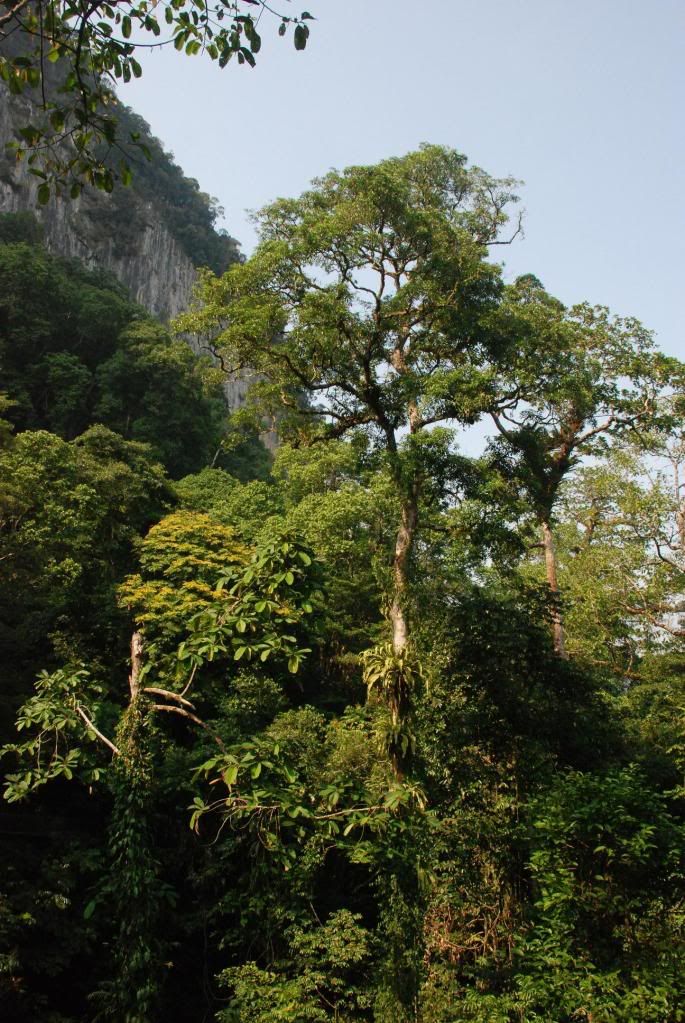
From the canopy walk - an 'emergent'
We were due to depart in the afternoon after 4 days in the park, but the flight was moved forward to avoid the worsening afternoon haze, so we left a little early and found ourselves back in Miri, eating large donuts and drinking Earl Grey in a classy shopping mall cafe. We had booked a dive trip the next day and so early the following morning found ourselves in Miri marina with a affable Westcountry expat called Steve, heading out to sample Miri's diving delights.
Billed as having underwater delights to rival much of southeast Asia, Miri didn't have bad dive sights but was not amazing - I have been well and truly spoilt though. The current El Nino, as well as causing the drought, has led to unusually choppy seas for this time of year and poor visibility for diving. Nevertheless, we had 2 good dives with schools of barracuda and jacks circling around us, before a third dive with awfulo visibility but some interesting macro lifeforms. All in all it was a thoroughly pleasant day out. That evening, our last in Sarawak, we headed over to the Taman Selera, a collection of outdoor seafood restaurants where we had eaten the preceeding week and been blown away by the rich and varied pickings , accompanied by the sound of breaking waves and a large Tiger beer.... or two.
Next destination is Brunei for just an overnight stop whilst in transit to Sabah. I'll try and fill you in on that lot before heading to Sulawesi at the end of August.
Many tourists come to Sarawak hoping to have a "genuine" longhouse experience or stay, and hand over good quantities of cash to effect this. The problem is, an authentic longhouse experience nowadays would involve eating some instant noodles whilst watching Malaysian soap operas on a TV turned to maximum volume - anything else is a show.
However, it was wildlife and not longhouses that brought me to Sarawak, and the following day we were off to the first of 6 National Parks that we would visit, Gunung Gading. Although it is the oldest park in Sarawak (started by Charles Brooke) and has a significant amount of primary rainforest, the main reason for the visit was to finally see a Rafflesia flower - the largest flower in the world - one of which was blooming at the moment. Our Rafflesia specimen was a little small (about 2 foot across) but impressive nonetheless. Fortunately it had not started smelling yet - it is pollinated by carrion flies and gives off a powerful stench of rotting meat to attract them. There were a few waterfalls further up the path which made for great swimming spots, excellent after a hot and humid slog up the trail.

Rafflesia flower

Waterfalls at Gunung Gading
Borneo is also home to orangutans - about 50,000 by most estimates, but their number is shrinking fast. A distinct sub-species from the Sumatran orangutan, it was only right to go and see a few at the Semengok Wildlife centre the next day at the feeding. Semengok has a very similar program of rehabilitation and release as the centre I visited in Bukit Lawang; so far it has released some 24 apes, of whom 4 have never returned to the regular feedings. After hiring a scooter for the day we whizzed over there and enjoyed the morning feeding in a much more formal setup than Sumatra, although we were able to get very close to a mother and baby after the main session had finished.



That added extra made us late for our next stop, Jongs Crocodile Farm. Billed as some kind of conservation effort (it was difficult to see how), Jongs had a huge number of wild and captive bred saltwater crocs from the coast of Sarawak. Twice a day they were fed with some fairly choice plucks, and the spectacle of watching the giant creatures leap some 10ft out of the water to grab them from the line was truly impressive. Their largest beast was some 16ft long and had been caught at a local river, although it had not eaten anyone unlike some of it's bethren, which a gallery of graphic photos demonstrated .



We popped back to Semegok for the afternoon feed and were rewarded with a close encounter with another oranguan as we walked through the arboretum - she seemed not to have a care in the world as she strolled past us looking for fruit.

Back in Kuching we made preparations to leave for a three day trip to Bako National Park the next day. We were constantly hounded around the city by the wail of police sirens as motorcades tore up the city. We found out that in a few days the Sultans of all the Malaysian states (including the King of Malaysia) were coming to town in a few days to celebrate the opening of the huge golden-roofed State Assembly on the opposite bank of the river.
The trip to Bako the next day was great, risk-of-crocodiles and falling into the water notwithstanding. Unreachable by road, Bako has a mix of lowland dipterocarp and heath rainforest, as well as a population of proboscis monkeys, endemic to Borneo. We had booked for a couple of nights in the Park HQ accommodation, and set about exploring the local trails to various idyllic beaches. It wasn't hard to spot the wildlife; the proboscis monkeys spent a lot of time around the Park HQ along with bearded pigs scrounging for food and long-tailed macaques who would actually steal food - or anything else left unattended for that matter.


The best beach was Pandan Kecil - a quiet bar of sand, overlooked by huge cliffs of moon-like dark rock and fringed on all sides by jungle. It was just like a jungle beach should be, right down to the jellyfish that gave me a good sting across my shoulder.


We tried spotting the proboscis monkeys early one morning as they were due to cross a walkway across a mangrove swamp - their regular route. They failed to appear although the boisterous macaques did, who showed no fear in investigating the cameras and one giving me a good pinch. The proboscis monkeys showed up an hour later at the Park HQ, feeding on a fruiting tree as the sun rose, paying no heed of the tourists clustered around with their large collection of SLRs and high-powered zooms.


Macaques

Proboscis monkey


Sunset at Bako....

...and the hermit crabs come out
Back from Bako we went to a concert - the first event celebrating the big opening of the assembly building. As the stars of Academi Fantasia (read Pop Idol) wailed out their latest hits (and I do mean wailed), the satay stalls nearby were by far the most exciting thing and sufficiently removed from the action to not risk aural damage.
The following day was a little more of the same and somewhat frustrating - being a Sunday most things were closed, including the Tourist Office, National Parks Office and motorbike rental places. We settled for a stroll along the increasingly busy waterfront, by now set up for a huge regatta the following day and teeming with all kinds of armed police on boats, bikes and jetskis. The constant noise of the motorcades as they swept imperiously around town added to the atmosphere, although by evening time it was strangely quiet as we crossed the river to enjoy some pansuh, a traditional dish slow-cooked in bamboo over a fire. That was disappointing: the bamboo used only to serve the pansuh in - it was probably stewed for a couple of hours in a large steel pot - and consisted of chicken (mostly bone) and a wide variety of inedible "jungle roots and ferns".
The carnival atmosphere came into it's own the next day, and we spent an hour standing in the sun awaiting the arrival of the King and various Sultans. We were well placed right by the red carpet where the armoured limousines would pull up, and I shook hands with at least one "important" person who nobody seemed to know. The main player of the day, the King, was a no-show as he decided to sleep in (it was past midday), but the other Sultans appeared, some of whom I could even recognise from the photos patriotically displayed in most businesses. The regatta started once all the royalty who were conscious had arrived, and there followed several dragon boat races up a rather choppy river. These races were great, not least for the fact that in every race at least one boat, overloaded with paddlers, would start to sink. That night the waterfront was incredibly busy with people seemingly just hanging around - we escaped back to the hostel and only re-emerged when a huge firework display lit up the sky around the new assembly building.
The following morning we turned our backs on Kuching and took a fast boat to Sibu, northeast across a bay of the South China Sea and then upriver some 60km. Our plan was to get to Kapit, a small logging town further upriver, and then from there get up to Belaga, an even smaller place about as far away from it all as you can get in Sarawak. The boat ride to Sibu was fast and efficient, and we transferred almost seamlessly to an express boat heading the 125km upriver to Kapit.
The express boats that ply the waterways of Sarawak are precisely that; very fast, resembling an aeroplane without wings, with a comically huge engine in the back and huge exhausts belching volumes out the back in an effort to get people where there are no roads. We arrived in Kapit as the sun was setting, found a hotel and a pasar malam (night market) with excellent food.

Express boat.... missing the wings needed for takeoff
Sibu, Kapit and Belaga are the main towns people visit for their "longhouse experience". Cynical as Hyun and I were of a genuine experience with financially motivated origins, we had decided to head up to Belaga by boat, and then go back to the coast by logging road to Bintulu, some 3 hours northeast Sibu by paved highway. We figured the journey would be experience enough..... but in order to get to Belaga, we had to get permission first.
Kapit is in the odd position of being unconnected to the outside world by road, but with some 4000 cars competing for 400 parking spaces on it's small amount of paved road. We got a lift to the Residents Office in the government building, a vast, 10 storey concrete and glass tower block that was as out of place in Kapit as it would have been had they built it in the Masai Mara. However, we were duly issued with permits for visiting Belaga, along with a few raised eyebrows and mutterings along the line of "You haven't a hope in hell".

Kapit - lots of cars with nowhere to go
Armed with permits we asked almost everyone with a boat if they would take us to Belaga... the answer was a resounding negative. Kapit lies on the Rejang River, and upstream was the mighty Pelagus Rapids which are impassable at the moment. Despite the best efforts of the British Army and a lot of dynamite in the 60's, the rapids are still only navigable when the water is high and you have a very powerful engine. We were fast becoming aware that not only was this the dry season, it had also been very dry, and passing the rapids was impossible. We headed back to Sibu with a wry grin.
On the boat to Sibu we met a few local Iban lads, who seemed very keen to take us back to their longhouse and ply us with beer. This could have been the "genuine" experience we were after, but not long after they were all asleep and we were left watching the modern longhouses that formed most settlements on the Rejang and the endless timber barges running downstream to the plywood factories.

One of the many timber barges
If you've ever wondered about the statistics involving deforestation of rainforest, you only need a short trip along the Rejang for those soundbites to become a cold reality. "An area the size of Wales every year" or "six football pitches every hour" becomes a little hard to visualise, but seeing barge after barge after barge loaded with timber, and seemingly endless factories churning out plywood from vast lumber yards, was a thoroughly depressing and humbling experience. There may be controls in place but believe the quotes, they are true - the rainforest is disappearing and at a rate you cannot imagine.

Plywood factory on the lower Rejang
Back in Sibu, barely 24 hours since arriving, and our Iban friends scarpered off the boat leaving us to get on a bus and carry on northeast up the coast. The next stop was Bintulu, a town booming fromboth a huge LNG reserve found offshore (Malaysia's largest reserve) and timber. It was not, in any way, shape or form, set up for tourism. After a staggering unsuccessful attempt to find a road full of good restaurants (it was only 40m from our hotel, but no-one knew that), we tried the following day to visit Similajau National Park, a coastal strip home to nice beaches and nesting turtles. It proved impossible to find a bus there or a motorbike to hire, and we gave up and had a relaxing day wandering around town, eventually finding the restaurant street ourselves, plus a small funfair for some evening entertainment to boot.
The following day we headed up to Niah National Park, another couple of hours northeast along the coast. We had booked a couple of days to explore the vast limestone caves there that are a feature of eastern Sarawak. The caves are so huge due to the very dense limestone found in the area - it allows for large caverns to develop but water dissolution/erosion whilst not collpasing. Niah was famous for a few of reasons. First was the bats - some 500,000 live in the the main Great Cave, and leave each night to be replaced by the second natural wonder - some half a million swifts that also call the cave home. For several hundred years the caves and their contents have been exploited - the bat guano has been mined, and the swift's nests are collected for birds nest soup.
The caves became of archaeological importantance in 1963 the Curator of Sarawak Museum found a human skull some 40,000 years old, forcing a total rethink of hominid occupation of island south-east Asia. There are a couple of hundred identified grave sites within the great cave, and within a smaller cave are the oldest cave paintings in Borneo, estimated at some 3,000 years old.
Hyun and I decided to save the below-ground for the following day, and headed on the only above ground trail to scale the heights of the limestone cliffs in which the caveas are found. It was a very steep 200m climb - a lot of it on ladders - but the view from the top was well worth it.

The next day we headed over to the caves in the afternoon, hoping to see them all and then the "changing of the guard" - when the bats left at dusk and the swifts returned to the cave. The caves were huge, awesome structures; in places roof collapses had left windows of daylight that played down into the cavern casting eerie shadows over boulders. There were a huge number of ladders and poles affixed to the roof to allow the birds nest harvesters to work. The job involves an incredibly risky climb up the poorly supported poles to the roof of the cave, where twice yearly the workers are allowed to takes nests and harvest the glutinous secretions that both bond the nest together and go into making the soup.

West Mouth of the Great Cave

Inside the great Cave - the hanging things are all poles for the bords nest harvesters

The paintings in the so-called "Painted Cave" were disappointing to say the least, protected by layers of fencing and barbed wire, but the pitch-black cave walk to get there was fabulous fun, though Hyun and I reflected that if we had each been alone it would have been just a little scary. We got back to the West Mouth of the Great Cave just before sunset, and sat down to watch. There was a steady stream of bats but not a huge number; at one point a bat hawk flew in to take a few easy pickings, and we left in total darkness wondering what all the fuss had been about - we saw pretty much nothing.

The Great Cave mouth by night.....
The following day - a Sunday - we arrived in Miri, our last city in Sarawak from where we intended to do some diving and visit a couple of National Parks. To cut a long story short, we spent the next 36 hours trying -and failing mostly - to sort out an independent trip to Gunung Mulu National Park. Everything was fully booked or close to being so - flights were full, accommodation at the Park was full, activities in the Park were full. We eventually bagged a couple of flights and tried to book a tour; when that failed, we had a stroke of good luck and picked up a room after a cancellation just hours before.

Miri lighthouse... or seahorse.....
Gunung Mulu NP is famous for it's limestone scenery - both vast cave networks and a series of limestone prominences, the Pinnacles, that make Malham Cove's karst scenery look decidely second rate. We knew that the Pinnacles trip was fully booked but assumed visiting the caves, canopy walk and other attractions would be easy... but first we had to get there.
We organised a brief day trip to another local National Park, Lambir Hills before heading to Mulu. Lambir Hills boasts the highest biodiversity per hectare identifed anywhere in the world, with a bewildering mix of tropical rainforest types. We went for the waterfalls and swimming to be had, although in the current drought they were reduced mainly to a trickle, and the views were obscured by an everpresent haze of smoke drifting from myriad fires over the border in Kalimantan.

Arrival, eventually, in Mulu
The following day the Mulu trip started well, at least. The flight in a large Twin Otter turboprop left about on time, but on descent to Mulu airfield the haze was too dense to see the runway with any degree of safety, and we headed back to Miri with another wry grin and wondering if the Mulu place was really worth the bother. MAS Wings, a division of Malaysian Airlines, did a sterling job and whilst I waited to get our baggage back Hyun got our replacement flight tickets for the following day - scheduled earlier to avoid the haze - plus accommodation in the local country club, complete with Olympic sized swimming pool. We had to take that one on the chin.
The following day, after 2km in the pool and a rather large breakfast, we were back on a Fokker 50 turboprop flying to Mulu. The haze semed identical but the pilot landed anyway, and we installed ourselves in a pleasant room at the Matumau lodge - a full board lodge with just a few rooms. Within an hour or two we had figured that many of the activites in the Park - run by a private business and charged in that way - were full. We eventually settled on a program taking in all the large "show" caves, plus short caving trip, a night walk and canopy trip. Part of the issue in Mulu NP is that there are not enough guides in peak season to cater for the numbers of tourists and trips fill up rapidly; there are very few trails to be walked independently as this would mean a loss of income for both the Park business and the local Penan villagers, many of whom are employed within the park.


Pygmy squirrel

Mulu boasts the largest cave chamber in the world - the Sarawak chamber - but this is unreachable except on a rather extreme caving trip. Instead, we did the one '4-5 hour' self-guided trail in the Park - it took 2 hours for the roundtrip and finished at a pretty sorry looking waterfall. Here as well the drought was clearly evident, from low water levels to wilting leaves. Afterward we visited the Deer and Langs Caves as part of a huge group, led by a guide who walked far too rapidly - we never saw her after we reached the cave. Langs cave was beautiful but the Deer cave and it's passage through to the Garden of Eden was awe-inspiring - it is the largest cave passage in the world and home to 2-3 million wrinkle-lipped bats. After leaving the caves we stopped at the "Bat Observatory" to watch the bats leave at dusk - groups of 100,000 bats would leave in a dense, heaving spirals, one after another. Niah paled in comparison.

Malham Cove, but with jungle. And caves. And much, much bigger.

Langs Cave

Heading into the Deer Cave

Deer Cave entrance

The Garden of Eden

Bat exodus

Bats! Count 'em.....
We filled the rest of our time at Mulu visiting more show caves and shelling out for trips that we could easily done ourselves - except our brief adenture caving trip. With all longer trips fully booked we had a 1 hour explore of Turtle cave that was great fun - just ourselves with a guide, scrambling and swimming through tunnels exploring small spaces and even being allowed to try and find the way ourselves briefly (my sometimes infallible sense of direction did not work underground).

Hyun in Wind Cave


Fearless on the canopy walk....

From the canopy walk - an 'emergent'
We were due to depart in the afternoon after 4 days in the park, but the flight was moved forward to avoid the worsening afternoon haze, so we left a little early and found ourselves back in Miri, eating large donuts and drinking Earl Grey in a classy shopping mall cafe. We had booked a dive trip the next day and so early the following morning found ourselves in Miri marina with a affable Westcountry expat called Steve, heading out to sample Miri's diving delights.
Billed as having underwater delights to rival much of southeast Asia, Miri didn't have bad dive sights but was not amazing - I have been well and truly spoilt though. The current El Nino, as well as causing the drought, has led to unusually choppy seas for this time of year and poor visibility for diving. Nevertheless, we had 2 good dives with schools of barracuda and jacks circling around us, before a third dive with awfulo visibility but some interesting macro lifeforms. All in all it was a thoroughly pleasant day out. That evening, our last in Sarawak, we headed over to the Taman Selera, a collection of outdoor seafood restaurants where we had eaten the preceeding week and been blown away by the rich and varied pickings , accompanied by the sound of breaking waves and a large Tiger beer.... or two.
Next destination is Brunei for just an overnight stop whilst in transit to Sabah. I'll try and fill you in on that lot before heading to Sulawesi at the end of August.

5 comments:
What a great blog! Loving your adventures and your photos
Pxxx
Hi, great blog. We are just about to leave for Kuching with our three kids for some adventure over 7 weeks in Sarawak and Sabah. Hopefully we have more luck with the longhouses!
Love your photos.
Love your pics!!! they tell how wonderful this world is!
I ate bird nest but I've never been to the caves. I used to buy bottles of bird nest soup like this as it is healthy and convenient:
hongkong-bird-nest.50webs.com
It looks nothing like a nest at all. ^.^ I feel like i am kept in a man made world, far far away from the nature.
I drank 2 cans of White Bird Nest everyday, but had no idea what benefits I was getting. Taste quite good and I knew it was good for me. I thought about how disgusting this type of ingredients would be, but am better than that, it benefited me more to drink besides its hard to get a hand on these expansive drink.
Hello Pete;
What an amazing opportunity to visit the Gunung Mulu National Park; personally, for the time being, I am only able to learn about this magical place through an IT research project and presentation. What brought me across your blog was a picture search on the Deer Cave. I would like your permission to source your photos of the Mulu caves and ,possibly, a few of your personal accounts of your experience in my project. I thank you to consider my request and for a timely response.
Cordially,
Maggie P.
Post a Comment